Java Certification
Practice Tests and Study Guide - Ultimate information about Oracle Java Certifications
"Why do I take Java Certification exam?"
"What is the need of Oracle Java Certification?"
"Do I get career benefits after completing Oracle Java Certification?"
"Is it really worth for the money spent for Java Certification?"
These are usual questions any Java Developer may ask themselves. This article answer all of these questions with complete information about Oracle Java Certifications.
The Java Certification program conducted by Oracle are respected by many industries, however few companies consider number of years of experience alone. You could gain programming experience in latest Java changes and new APIs.
A Java Certification included in your portfolio of skills definitely improve the chance of promotion or role changes. A Java Fresher may get added advantages to land in a Job.
The Java Certifications are re-branded after Oracle takeover Sun. There are four levels in Oracle Java Certification path:
- Associate Level
- Professional Level
- Expert Level
- Master Level
The main goal of Oracle Java Certification is to test your programming or design skills. There is only one design skill certification available at master level.
The Java Certifications are organized with platform editions and versions. Each Java certification can have a different version of the same certification corresponding to Java SE or Java EE versions.
Associate Level Java Certifications
The following Java Certifications are under Associate Level:
Java Foundations Certified Junior Associate Certification
Learn More StudyPlan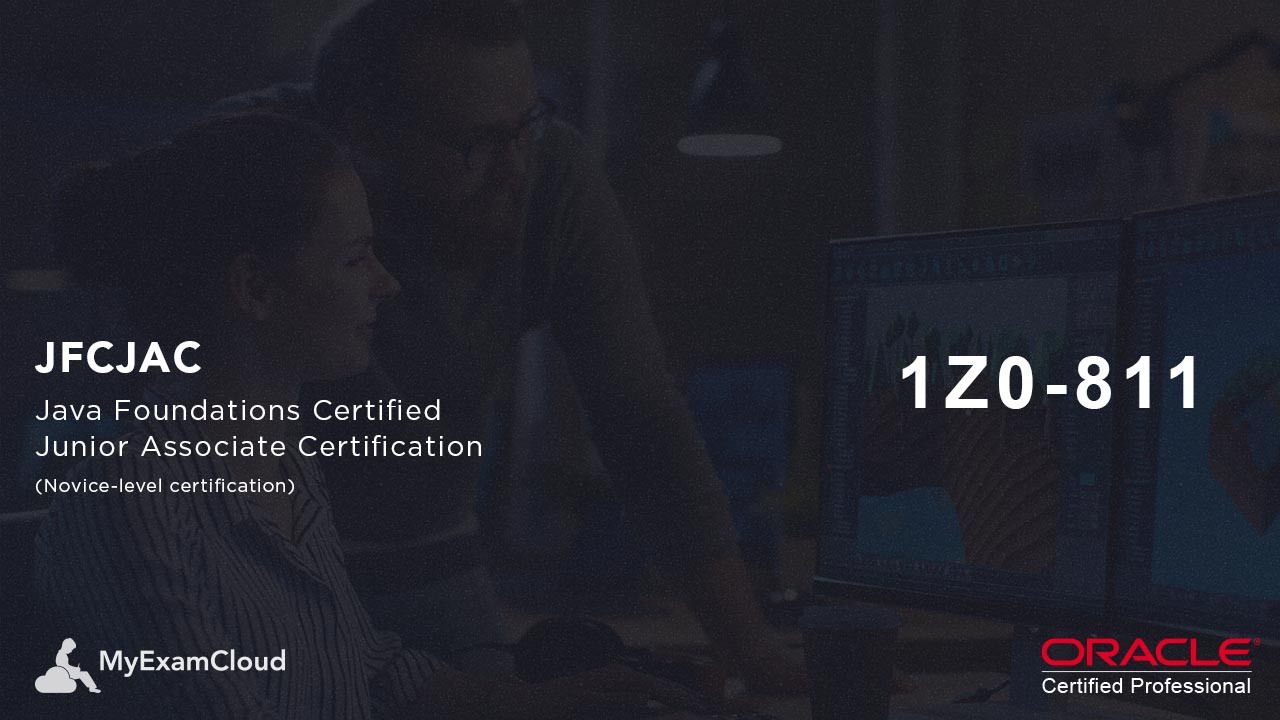
Certification Overview
The Java Foundations Certified Junior Associate exams tests fundamentals of Java programming. You could gain more respect from IT companies while doing your internship after completing this certification.
According to Oracle "This Junior Associate certification is focused on students in secondary schools, two-year colleges and four year colleges and universities who have participated in the Oracle Academy program and/or are studying computer science including relevant Java curricula and faculty members who teach foundational Java and computer science classes".
Certification Process
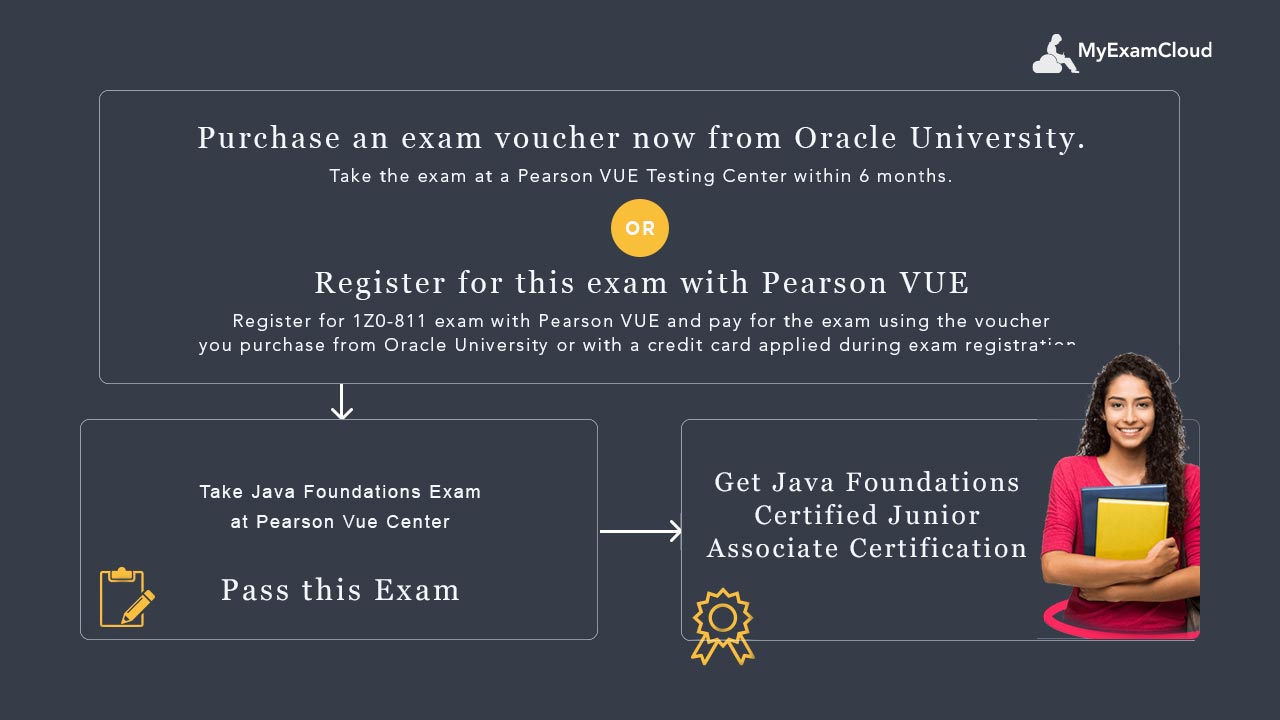
Exam Details
Java Foundations Certified Junior Associate (novice-level certification)
| Exam Number | 1Z0-811 |
|---|---|
| Exam Name | Java Foundations (novice-level exam) |
| Recommended Training Course (Optional) | Java Foundations |
| Exam Duration | 150 minutes |
| Total Number of Questions | 75 |
| Exam Passing Score | 65% |
| Validated Against | JDK 1.8 |
| Exam Format | Multiple Choice |
Syllabus
What Is Java?
- Describe the features of Java
- Describe the real-world applications of Java
Basic Java Elements
- Identify the conventions to be followed in a Java program
- Use Java reserved words
- Use single-line and multi-line comments in Java programs
- Import other Java packages to make them accessible in your code
- Describe the java.lang package
Working with Java Operator
- Use basic arithmetic operators to manipulate data including +, -, *, /, and %
- Use the increment and decrement operators
- Use relational operators including ==, !=, >, >=, <, and <=
- Use arithmetic assignment operators
- Use conditional operators including &&, ||, and ?
- Describe the operator precedence and use of parenthesis
Working with the Random and Math Classes
- Use the Random class
- Use the Math class
Using Looping Statements
- Describe looping statements
- Use a for loop including an enhanced for loop
- Use a while loop
- Use a do- while loop
- Compare and contrast the for, while, and do-while loops
- Develop code that uses break and continue statements
Arrays and ArrayLists
- Use a one-dimensional array
- Create and manipulate an ArrayList
- Traverse the elements of an ArrayList by using iterators and loops including the enhanced for loop
- Compare an array and an ArrayList
Java Methods
- Describe and create a method
- Create and use accessor and mutator methods
- Create overloaded methods
- Describe a static method and demonstrate its use within a program
Java Basics
- Describe the Java Development Kit (JDK) and the Java Runtime Environment (JRE)
- Describe the components of object-oriented programming
- Describe the components of a basic Java program
- Compile and execute a Java program
Working with Java Data Types
- Declare and initialize variables including a variable using final
- Cast a value from one data type to another including automatic and manual promotion
- Declare and initialize a String variable
Working with the String Class
- Develop code that uses methods from the String class
- Format Strings using escape sequences including %d, %n, and %s
Using Decision Statements
- Use the decision making statement (if-then and if-then-else)
- Use the switch statement
- Compare how == differs between primitives and objects
- Compare two String objects by using the compareTo and equals methods
Debugging and Exception Handling
- Identify syntax and logic errors
- Use exception handling
- Handle common exceptions thrown
- Use try and catch blocks
Classes and Constructors
- Create a new class including a main method
- Use the private modifier
- Describe the relationship between an object and its members
- Describe the difference between a class variable, an instance variable, and a local variable
- Develop code that creates an object's default constructor and modifies the object's fields
- Use constructors with and without parameters
- Develop code that overloads constructors
Preparation
Sample content The OCAJP 8 (Oracle Certified Associate, Java SE 8 Programmer) certification improves object-orientated programming and Java fundamental skills. This Java Certification also tests Java SE 8 new features such as 'Lambda expressions' and 'Date and Time API'. As Java Language Specification has been updated for these new features, the experienced Java developers also need to learn the new style of coding by preparing for this exam.
Who can take this certification?
This is a novice-level exam for candidates who are students at secondary schools, 2-year colleges and 4-year colleges and universities. If you are seeking a more career-level certification, you may consider purusing Oracle Database 12c Administrator Certified Associate or Oracle Database 11g Administrator Certified Associate. Those exams are more appropriate for candidates who have completed training though Oracle University or Oracle's WDP program.
Benifits
Earning the Java Foundations Certified Junior Associate credential arms you withthe fundamentalsof Java programming,enabling you to demonstrate both conceptual knowledge and skills. Certification alsovalidates your capabilities to a future employer, showing your potential to become an increasingly valuable asset to any company as you progress into OCA level during your early stage of employment, and later to OCP.
Success Story
Thanh son Le
I found the Training Lab Exams to be fantastic! The questions were more intense than the actual exams. It has become a common practice for the training staff at our company to recommend your products. Thanks!
Oracle Certified Associate, Java SE 7 Programmer
Learn More StudyPlan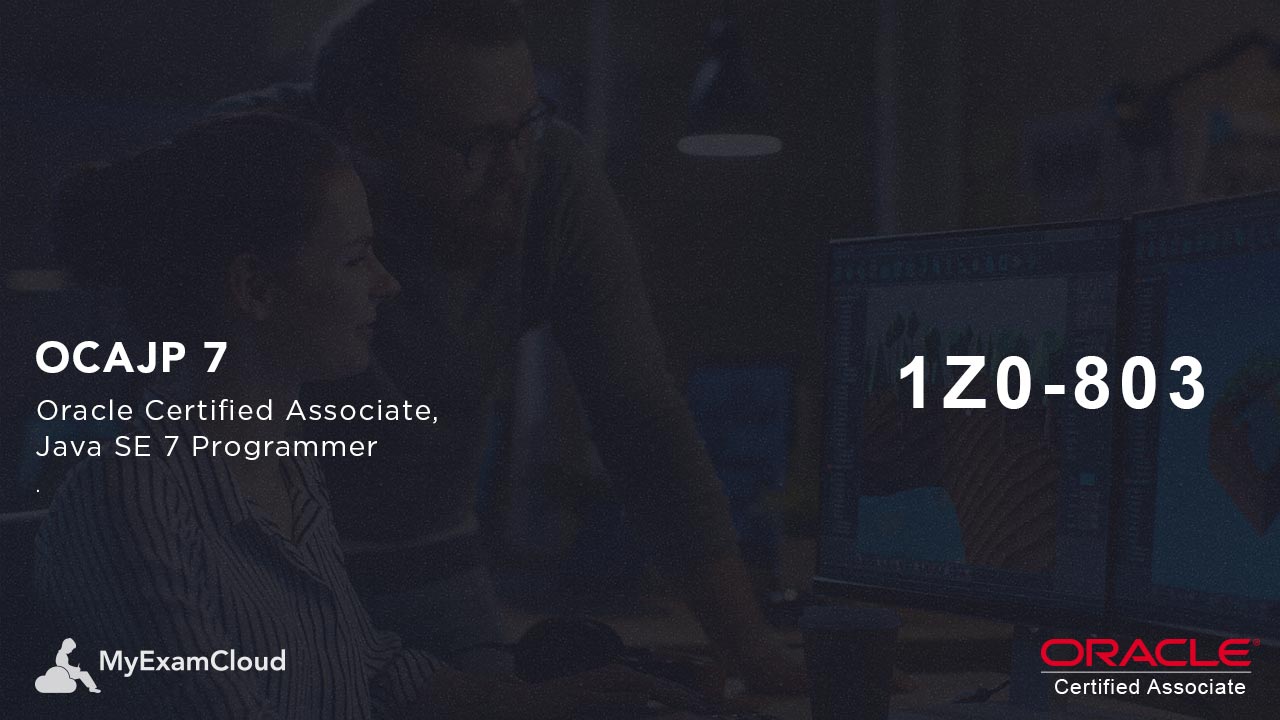
Certification Overview
The OCAJP 7 (Oracle Certified Associate, Java SE 7 Programmer) certification improves object-orientated programming and Java fundamental skills. This Java Certification also tests few Java SE 7 new features.
Binary Literals - In Java SE 7, the integral types (byte, short, int, and long) can also be expressed using the binary number system. To specify a binary literal, add the prefix 0b or 0B to the number.
Underscores in Numeric Literals - Any number of underscore characters (_) can appear anywhere between digits in a numerical literal. This feature enables you, for example, to separate groups of digits in numeric literals, which can improve the
Certification Process
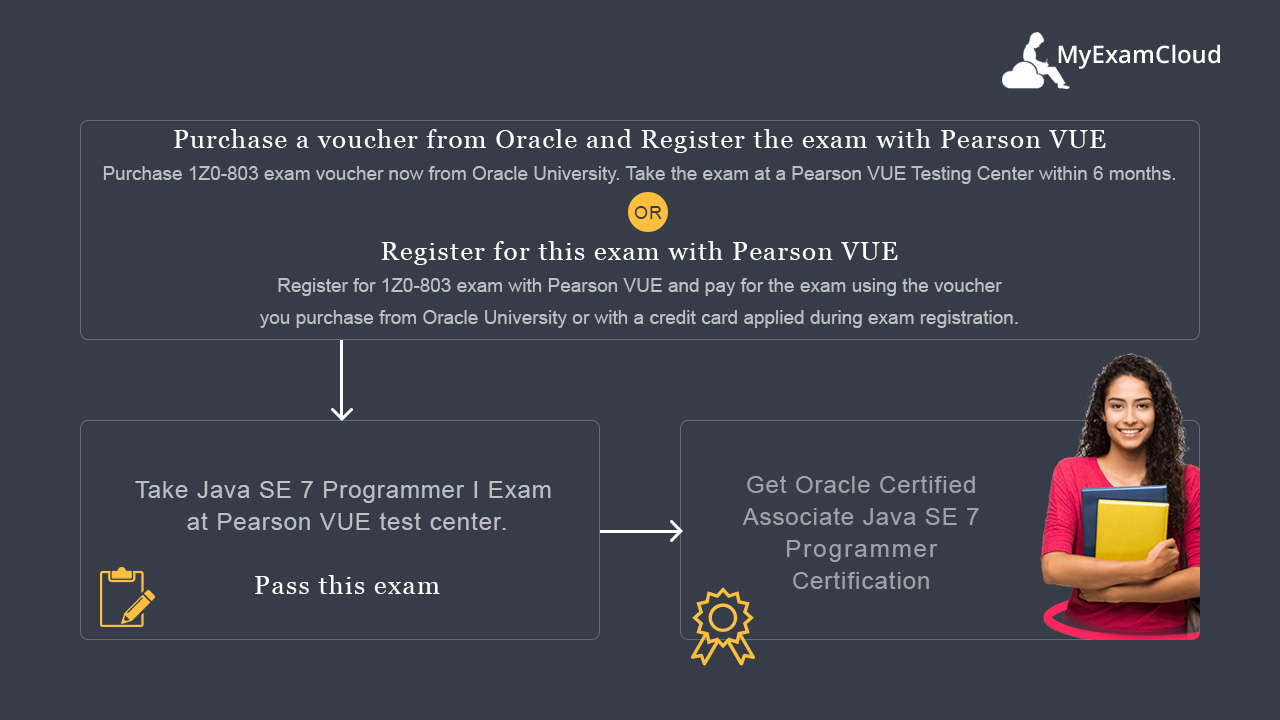
Exam Details
| Exam Number | 1Z0-803 |
|---|---|
| Exam Name | Java SE 7 Programmer I |
| Recommended Training Course (Optional) | Java SE 7 Fundamentals |
| Duration | 150 minutes |
| Number of Questions | 70 |
| Passing Score | 63% |
| Validated Against | SE 7 |
| Format | Multiple Choice |
Syllabus
Java Basics
- Define the scope of variables
- Define the structure of a Java class
- Create executable Java applications with a main method
- Import other Java packages to make them accessible in your code
Working With Java Data Types
- Declare and initialize variables
- Differentiate between object reference variables and primitive variables
- Read or write to object fields
- Explain an Object's Lifecycle (creation, "dereference" and garbage collection)
- Call methods on objects
- Manipulate data using the StringBuilder class and its methods
- Creating and manipulating Strings
Using Operators and Decision Constructs
- Use Java operators
- Use parenthesis to override operator precedence
- Test equality between Strings and other objects using == and equals ()
- Create if and if/else constructs
- Use a switch statement
Creating and Using Arrays
- Declare, instantiate, initialize and use a one-dimensional array
- Declare, instantiate, initialize and use multi-dimensional array
- Declare and use an ArrayList
Using Loop Constructs
- Create and use while loops
- Create and use for loops including the enhanced for loop
- Create and use do/while loops
- Compare loop constructs
- Use break and continue
Working with Methods and Encapsulation
- Create methods with arguments and return values
- Apply the static keyword to methods and fields
- Create an overloaded method
- Differentiate between default and user defined constructors
- Create and overload constructors
- Apply access modifiers
- Apply encapsulation principles to a class
- Determine the effect upon object references and primitive values when they are passed into methods that change the values
Working with Inheritance
- Implement inheritance
- Develop code that demonstrates the use of polymorphism
- Differentiate between the type of a reference and the type of an object
- Determine when casting is necessary
- Use super and this to access objects and constructors
- Use abstract classes and interfaces
Handling Exceptions
- Differentiate among checked exceptions, RuntimeExceptions and Errors
- Create a try-catch block and determine how exceptions alter normal program flow
- Describe what Exceptions are used for in Java
- Invoke a method that throws an exception
- Recognize common exception classes and categories
Preparation
Sample content for preparation. Sample content for preparation. Sample content for preparation. Sample content for preparation.
Who can take this certification?
Set The New Java Standard With Java SE 7 OCA Certification Java SE 7 significantly changes the way you write code. Java SE 7 Certification gives you the tools to make the most of new features. The Java SE 7 Oracle Certified Associate (OCA) certification provides a foundational understanding of Java as well as programming in general. So it suits for most Java Professionals starting from beginner to expert.
- College Students
- Java Developer looking for Job
- Java Trainers
- Java Developers
Benifits
The reason for taking Oracle Java Certification is to differentiate general programmers from certified experts. You may get additional benefits like getting a good job, salary hike, designation changes, role changes and higher promotion.
Stand out from the millions of Java crowd. Increase your marketability with OCAJP 7 Certification on the most used programming language in the world - Java.
Related Articles: https://www.epractizelabs.com/myexamcloud/2017/04/20/oracle-java-certification-exam-preparation/
Success Story
Thanh son Le
I found the Training Lab Exams to be fantastic! The questions were more intense than the actual exams. It has become a common practice for the training staff at our company to recommend your products. Thanks!
Oracle Certified Associate, Java SE 8 Programmer
Learn More StudyPlan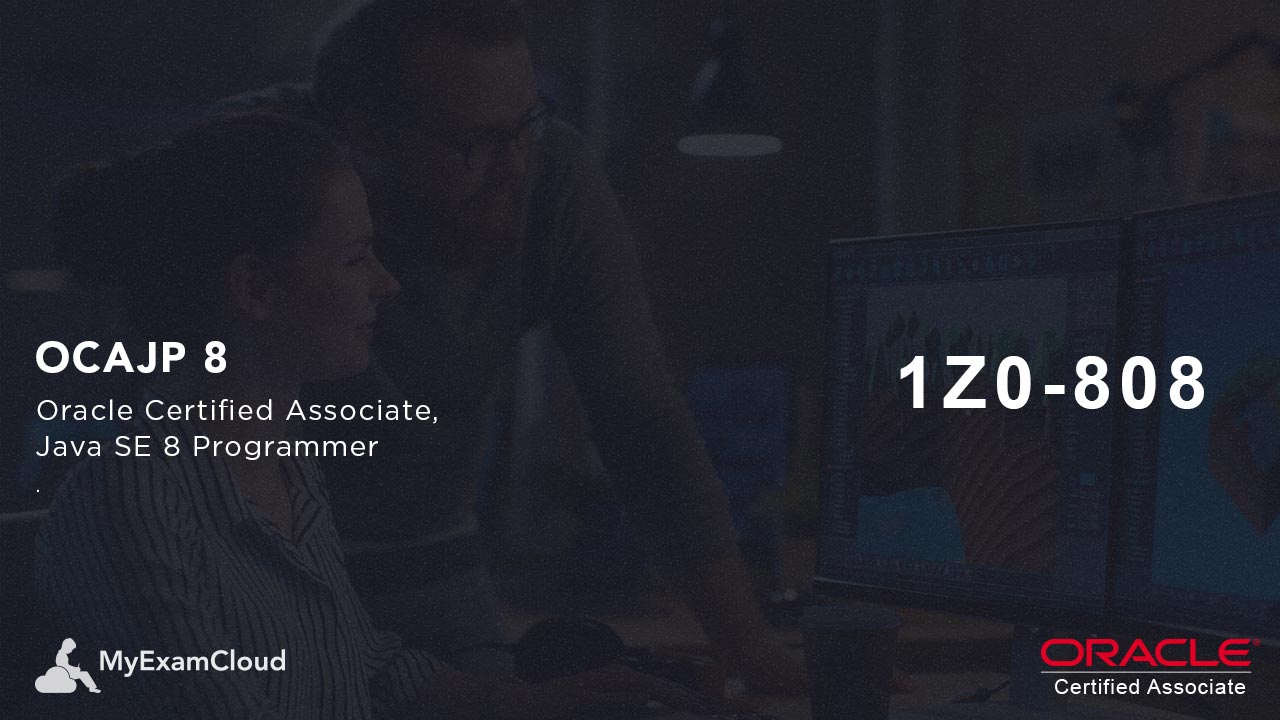
Certification Overview
The OCAJP 8 (Oracle Certified Associate, Java SE 8 Programmer) certification improves object-orientated programming and Java fundamental skills. This Java Certification also tests Java SE 8 new features such as 'Lambda expressions' and 'Date and Time API'. As Java Language Specification has been updated for these new features, the experienced Java developers also need to learn the new style of coding by preparing for this exam.
Java SE 8 Programmer I: The is a beginner level exam – If you pass it you get Oracle Certified Associate Java SE 8 Programmer (OCAJP 8) certification. There are no pre-requisites for taking this exam.
Certification Process
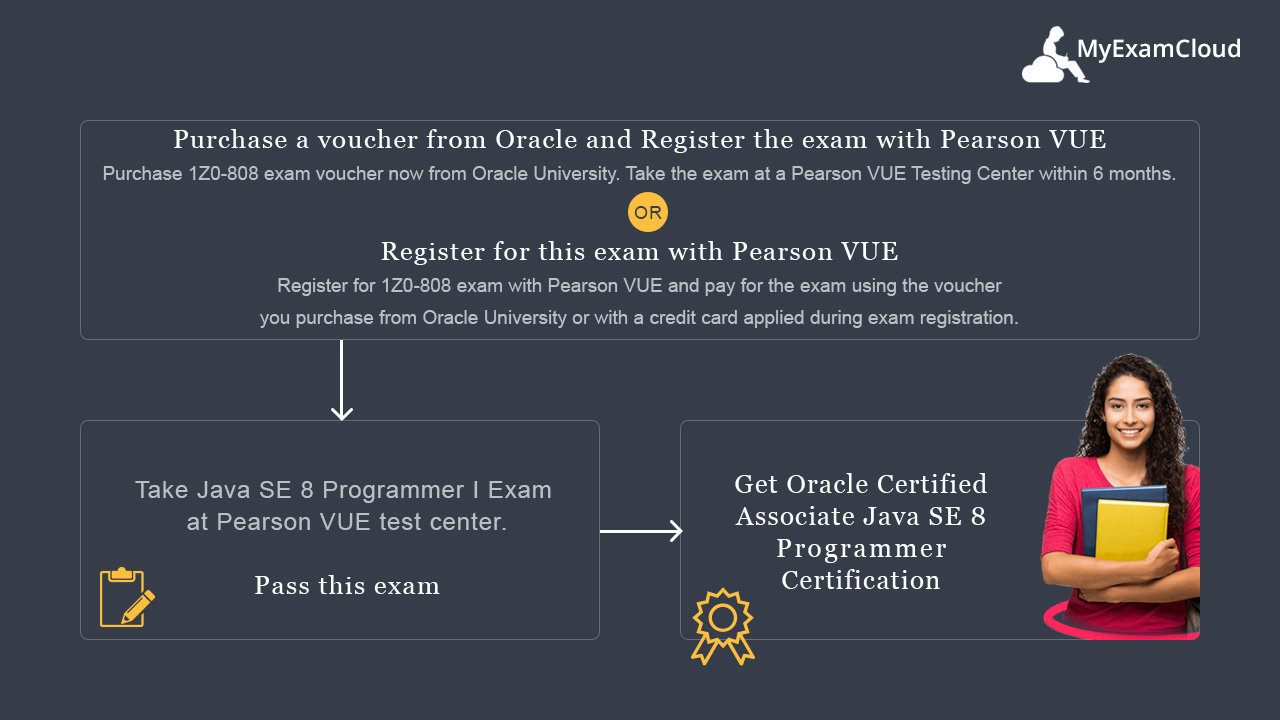
Exam Details
| Exam Number | 1Z0-808 |
|---|---|
| Exam Name | Java SE 8 Programmer I |
| Exam Duration | 150 minutes |
| Total Number of Questions | 70 |
| Passing Score | 65% |
| Validated Against | SE 8 |
| Format | Multiple Choice |
Syllabus
Java Basics
- Define the scope of variables
- Define the structure of a Java class
- Create executable Java applications with a main method; run a Java program from the command line; produce console output
- Import other Java packages to make them accessible in your code
- Compare and contrast the features and components of Java such as: platform independence, object orientation, encapsulation, etc.
Working With Java Data Types
- Declare and initialize variables (including casting of primitive data types)
- Differentiate between object reference variables and primitive variables
- Know how to read or write to object fields
- Explain an Object's Lifecycle (creation, "dereference by reassignment" and garbage collection)
- Develop code that uses wrapper classes such as Boolean, Double, and Integer
Using Operators and Decision Constructs
- Use Java operators; use parentheses to override operator precedence
- Test equality between Strings and other objects using == and equals ()
- Create if and if/else and ternary constructs
- Use a switch statement
Creating and Using Arrays
- Declare, instantiate, initialize and use a one-dimensional array
- Declare, instantiate, initialize and use multi-dimensional arrays
Using Loop Constructs
- Create and use while loops
- Create and use for loops including the enhanced for loop
- Create and use do/while loops
- Compare loop constructs
- Use break and continue
Working with Methods and Encapsulation
- Create methods with arguments and return values; including overloaded methods
- Apply the static keyword to methods and fields
- Create and overload constructors; differentiate between default and user defined constructors
- Apply access modifiers
- Apply encapsulation principles to a class
- Determine the effect upon object references and primitive values when they are passed into methods that change the values
Working with Inheritance
- Describe inheritance and its benefits
- Develop code that makes use of polymorphism; develop code that overrides methods; differentiate between the type of a reference and the type of an object
- Determine when casting is necessary
- Use super and this to access objects and constructors
- Use abstract classes and interfaces
Handling Exceptions
- Differentiate among checked exceptions, unchecked exceptions, and Errors
- Create a try-catch block and determine how exceptions alter normal program flow
- Describe the advantages of Exception handling
- Create and invoke a method that throws an exception
- Recognize common exception classes (such as NullPointerException, ArithmeticException, ArrayIndexOutOfBoundsException, ClassCastException)
Working with Selected classes from the Java API
- Manipulate data using the StringBuilder class and its methods
- Create and manipulate Strings
- Create and manipulate calendar data using classes from java.time.LocalDateTime, java.time.LocalDate, java.time.LocalTime, java.time.format.DateTimeFormatter, java.time.Period
- Declare and use an ArrayList of a given type
- Write a simple Lambda expression that consumes a Lambda Predicate expression
Preparation
Sample content for preparation. Sample content for preparation. Sample content for preparation. Sample content for preparation.
Who can take this certification?
Set The New Java Standard With Java SE 8 OCA Certification. Java SE 8 significantly changes the way you write code. Java SE 8 Certification gives you the tools to make the most of new features. The Java SE 8 Oracle Certified Associate (OCA) certification provides a foundational understanding of Java as well as programming in general. So it suits for most Java Professionals starting from beginner to expert.
- College Students
- Java Developer looking for Job
- Java Trainers
- Java Developers
Benifits
The reason for taking Oracle Java Certification is to differentiate general programmers from certified experts. You may get additional benefits like getting a good job, salary hike, designation changes, role changes and higher promotion.
Stand out from the millions of Java crowd. Increase your marketability with OCAJP 8 Certification on the most used programming language in the world - Java.
Related Articles:https://www.epractizelabs.com/myexamcloud/2017/04/20/oracle-java-certification-exam-preparation/
Success Story
Thanh son Le
I found the Training Lab Exams to be fantastic! The questions were more intense than the actual exams. It has become a common practice for the training staff at our company to recommend your products. Thanks!
Professional Level - Java EE
Java EE Professional Certification
Oracle Certified Professional, Java EE 7 Application Developer
Learn More StudyPlan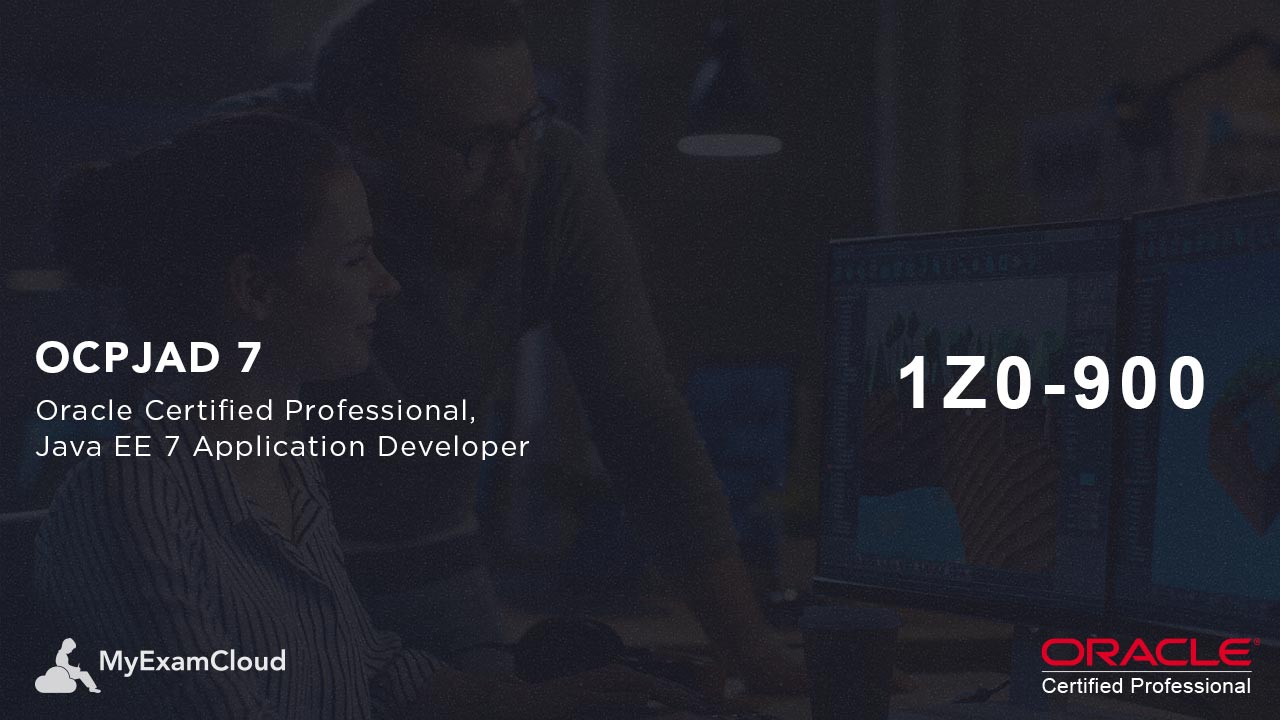
Certification Overview
The Java EE 7 Application Developer (Oracle Certified Professional, Java EE 7 Application Developer) certification improves object-orientated programming and Java fundamental skills. This Java Certification also tests Java SE 7 new features such as 'Lambda expressions' and 'Date and Time API'. As Java Language Specification has been updated for these new features, the experienced Java developers also need to learn the new style of coding by preparing for this exam.
Certification Process

Exam Details
| Exam Name | Java EE 7 Application Developer |
|---|---|
| Exam Number | 1Z0-900 |
| Format | Multiple Choice |
| Duration | 150 Minutes |
| Number of Questions | 70 |
| Passing Score | 66% |
| Validated Against | Exam has been validated against Java EE 7. |
Syllabus
Understand Java EE Architecture
- Describe Java EE 7 standards, containers, APIs, and services
- Differentiate between application component functionalities as they apply to different tiers and containers, including Java EE Web Container, Business Logic implementation and WebServices
- Create, package and deploy Java EE application
- Demonstrate understanding of Enterprise JavaBeans and CDI beans, their lifecycle and memory scopes
- Demonstrate understanding of the relationship between bean components, annotations, injections, and JNDI
Implement Business Logic by Using EJBs
- Create session EJB components containing synchronous and asynchronous business methods, manage the life cycle container callbacks and use interceptors
- Demonstrate understanding of how to control EJB transactions, distinguish Container Managed (CMT) and Bean Managed (BMT) transactions
- Create EJB timers
Implement SOAP Services by Using JAX-WS and JAXB APIs
- Create SOAP Web Services and Clients using JAX-WS API
- Define Java to XML Schema mappings to marshall and unmarshall Java Objects by using JAXB API
Create Java Web Applications using JSPs
- Describe JSP life cycle
- Describe JSP syntax, use tag libraries and Expression Language (EL)
- Handle errors using Servlets and Java Server Pages
Create Java Applications using WebSockets
- Understand and utilise WebSockets communication style and lifecycle
- Create WebSocket Server and Client Endpoint Handlers using JSR 356 API and JavaScript
- Produce and consume, encode and decode WebSocket messages
Secure Java EE 7 Applications
- Describe Java EE declarative and programmatic security and configure authentication using application roles and security constraints and Login Modules
- Describe WebServices security standards
Use Concurrency API in Java EE 7 Applications
- Demonstrate understanding of Java Concurrency Utilities and use Managed Executors
Manage Persistence using JPA Entities and BeanValidation
- Create JPA Entity and Relationship Object-Relational Mappings (ORM)
- Use Entity Manager to perform database operations, transactions and locking with JPA entities
- Handle entity data with conversions, validations, and key generation
- Create and execute JPQL statements
Use Java Message Service API
- Describe the Java Message Service (JMS) messaging models and implement Java SE and Java EE message producers and consumers, including Message-Driven beans
- Use transactions with JMS API
Create Java Web Applications using Servlets
- Create Java Servlets, describe how they are mapped to urls and use HTTP methods
- Handle HTTP headers, parameters, cookies
- Manage servlet life cycle with container callback methods and WebFilters
Implement REST Services using JAX-RS API
- Understand and Apply REST service conventions
- Create REST Services and clients using JAX-RS API
Develop Web Applications using JSFs
- Describe JSF arcitecture, lifecycle and navigation
- Understand JSF syntax and use JSF Tag Libraries
- Handle localisation and produce messages
- Use Expression Language (EL) and interact with CDI beans
Use CDI Beans
- Create CDI Bean Qualifiers, Producers, Disposers, Interceptors, Events and Stereotypes
Use Batch API in Java EE 7 Applications
- Describe batch jobs using JSL XML documents and JSR 352 API
Preparation
Sample content for preparation. Sample content for preparation. Sample content for preparation. Sample content for preparation.
Who can take this certification?
Set The New Java Standard With Java EE 7 OCP Certification. Java EE 7 significantly changes the way you write code. Java SE 8 Certification gives you the tools to make the most of new features. The Java EE 7 Oracle Certified Professional (OCP) certification provides a foundational understanding of Java as well as programming in general. So it suits for most Java Professionals starting from beginner to expert.
- College Students
- Java Developer looking for Job
- Java Trainers
- Java Developers
Benifits
The reason for taking Oracle Java Certification is to differentiate general programmers from certified experts. You may get additional benefits like getting a good job, salary hike, designation changes, role changes and higher promotion.
Stand out from the millions of Java crowd. Increase your marketability with Java EE 7 Application Developer Certification on the most used programming language in the world - Java.
Related Articles:https://www.epractizelabs.com/myexamcloud/2018/06/20/java-ee-7-application-developer-certification/
Success Story
Thanh son Le
I found the Training Lab Exams to be fantastic! The questions were more intense than the actual exams. It has become a common practice for the training staff at our company to recommend your products. Thanks!
Professional Level - Java SE
Java SE Professional Certification
Oracle Certified Professional, Java SE 8 Programmer
Learn More StudyPlan
Certification Overview
The OCPJP 8 (Oracle Certified Professional, Java SE 8 Programmer) certification improves object-orientated programming and Java fundamental skills. This Java Certification also tests Java SE 8 new features such as 'Lambda expressions', 'Streams', 'Concurrenyc' and 'Date and Time API'. As Java Language Specification has been updated for these new features, the experienced Java developers also need to learn the new style of coding by preparing for this exam.
Few important changes of Java SE 8 are:
Lambda Expressions, a new language feature, has been introduced in this release. They enable you to treat functionality as a method argument, or code as data. Lambda expressions let you express instances of single-method interfaces (referred to as functional interfaces) more compactly.
Method references provide easy-to-read lambda expressions for methods that already have a name.
Default methods enable new functionality to be added to the interfaces of libraries and ensure binary compatibility with code written for older versions of those interfaces
Classes in the new java.util.stream package provide a Stream API to support functional-style operations on streams of elements. The Stream API is integrated into the Collections API, which enables bulk operations on collections, such as sequential or parallel map-reduce transformations.
Classes and interfaces have been added to the java.util.concurrent package.
Methods have been added to the java.util.concurrent.ConcurrentHashMap class to support aggregate operations based on the newly added streams facility and lambda expressions.
Classes have been added to the java.util.concurrent.atomic package to support scalable updatable variables.
Methods have been added to the java.util.concurrent.ForkJoinPool class to support a common pool.
The java.util.concurrent.locks.StampedLock class has been added to provide a capability-based lock with three modes for controlling read/write access.
Certification Process
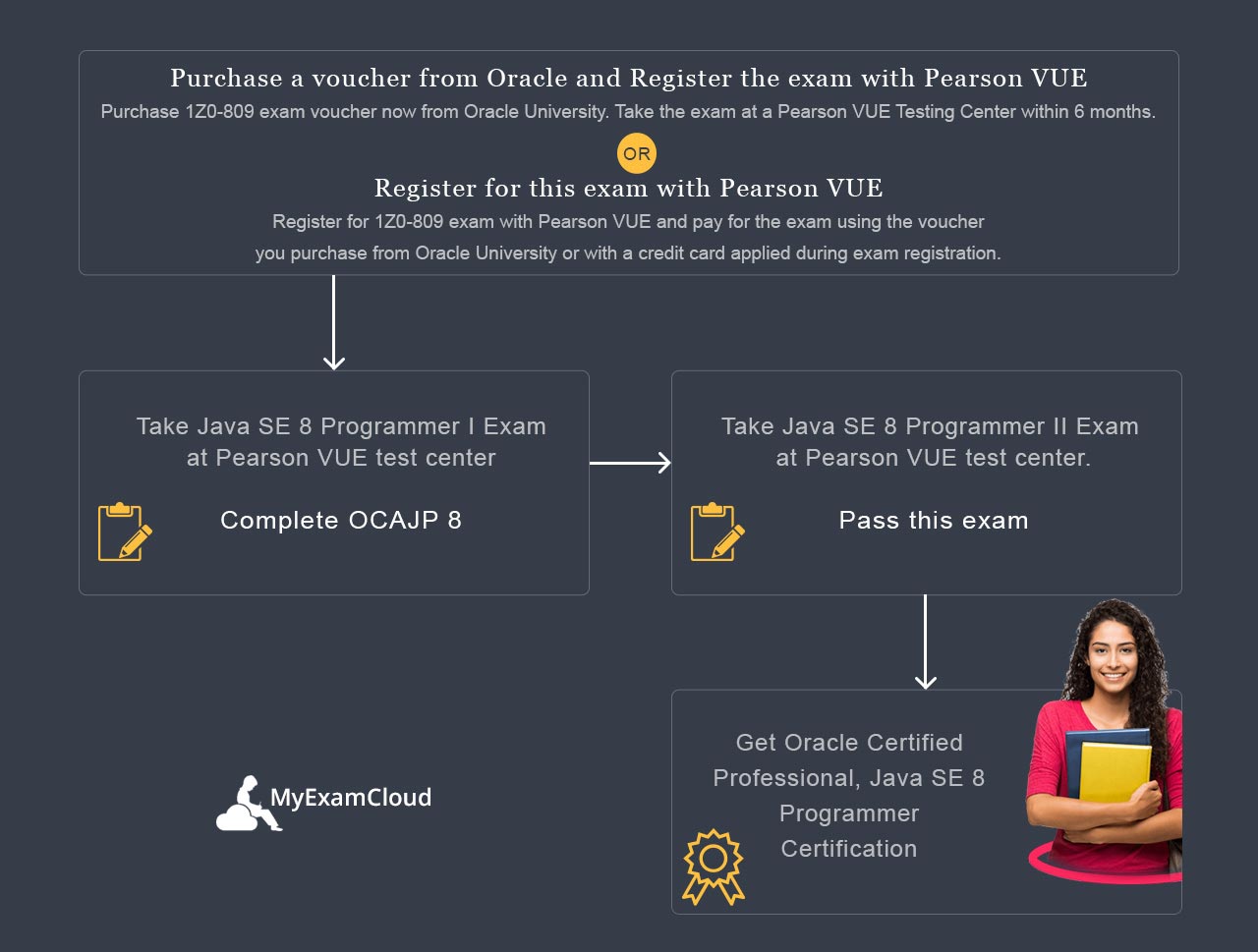
Exam Details
| Exam Number | 1Z0-809 |
|---|---|
| Exam Name | Java SE 8 Programmer II |
| Exam Duration | 150 minutes |
| Number of Questions | 70 |
| Passing Score | 65% |
| Validated Against | SE 8 |
| Format | Multiple Choice |
Syllabus
Java Class Design
- Implement encapsulation
- Implement inheritance including visibility modifiers and composition
- Implement polymorphism
- Override hashCode, equals, and toString methods from Object class
- Create and use singleton classes and immutable classes
- Develop code that uses static keyword on initialize blocks, variables, methods, and classes
Advanced Java Class Design
- Develop code that uses abstract classes and methods
- Develop code that uses the final keyword
- Create inner classes including static inner class, local class, nested class, and anonymous inner class
- Use enumerated types including methods, and constructors in an enum type
- Develop code that declares, implements and/or extends interfaces and use the @Override annotation.
- Create and use Lambda expressions
Generics and Collections
- Create and use a generic class
- Create and use ArrayList, TreeSet, TreeMap, and ArrayDeque objects
- Use java.util.Comparator and java.lang.Comparable interfaces
- Collections Streams and Filters
- Iterate using forEach methods of Streams and List
- Describe Stream interface and Stream pipeline
- Filter a collection by using lambda expressions
- Use method references with Streams
Lambda Built-in Functional Interfaces
- Use the built-in interfaces included in the java.util.function package such as Predicate, Consumer, Function, and Supplier
- Develop code that uses primitive versions of functional interfaces
- Develop code that uses binary versions of functional interfaces
- Develop code that uses the UnaryOperator interface
Java Stream API
- Develop code to extract data from an object using peek() and map() methods including primitive versions of the map() method
- Search for data by using search methods of the Stream classes including findFirst, findAny, anyMatch, allMatch, noneMatch
- Develop code that uses the Optional class
- Develop code that uses Stream data methods and calculation methods
- Sort a collection using Stream API
- Save results to a collection using the collect method and group/partition data using the Collectors class
- Use flatMap() methods in the Stream API
Exceptions and Assertions
- Use try-catch and throw statements
- Use catch, multi-catch, and finally clauses
- Use Autoclose resources with a try-with-resources statement
- Create custom exceptions and Auto-closeable resources
- Test invariants by using assertions
Use Java SE 8 Date/Time API
- Create and manage date-based and time-based events including a combination of date and time into a single object using LocalDate, LocalTime, LocalDateTime, Instant, Period, and Duration
- Work with dates and times across timezones and manage changes resulting from daylight savings including Format date and times values
- Define and create and manage date-based and time-based events using Instant, Period, Duration, and TemporalUnit
Java I/O Fundamentals
- Read and write data from the console
- Use BufferedReader, BufferedWriter, File, FileReader, FileWriter, FileInputStream, FileOutputStream, ObjectOutputStream, ObjectInputStream, and PrintWriter in the java.io package.
Java File I/O (NIO.2)
- Use Path interface to operate on file and directory paths
- Use Files class to check, read, delete, copy, move, manage metadata of a file or directory
- Use Stream API with NIO.2
Java Concurrency
- Create worker threads using Runnable, Callable and use an ExecutorService to concurrently execute tasks
- Identify potential threading problems among deadlock, starvation, livelock, and race conditions
- Use synchronized keyword and java.util.concurrent.atomic package to control the order of thread execution
- Use java.util.concurrent collections and classes including CyclicBarrier and CopyOnWriteArrayList
- Use parallel Fork/Join Framework
- Use parallel Streams including reduction, decomposition, merging processes, pipelines and performance.
Building Database Applications with JDBC
- Describe the interfaces that make up the core of the JDBC API including the Driver, Connection, Statement, and ResultSet interfaces and their relationship to provider implementations
- Identify the components required to connect to a database using the DriverManager class including the JDBC URL
- Submit queries and read results from the database including creating statements, returning result sets, iterating through the results, and properly closing result sets, statements, and connections
Localization
- Read and set the locale by using the Locale object
- Create and read a Properties file
- Build a resource bundle for each locale and load a resource bundle in an application
Preparation
Sample content for preparation. Sample content for preparation. Sample content for preparation. Sample content for preparation.
Who can take this certification?
Set The New Java Standard With Java SE 8 OCP Certification Java SE 8 significantly changes the way you write code. Java SE 8 Certification gives you the tools to make the most of new features. The Java SE 8 Oracle Certified Professional (OCP) certification provides a foundational understanding of Java as well as programming in general. So it suits for most Java Professionals starting from beginner to expert.
- College Students
- Java Developer looking for Job
- Java Trainers
- Java Developers
Benifits
The reason for taking Oracle Java Certification is to differentiate general programmers from certified experts. You may get additional benefits like getting a good job, salary hike, designation changes, role changes and higher promotion.
Stand out from the millions of Java crowd. Increase your marketability with OCPJP 7 Upgrade Certification on the most used programming language in the world - Java.
Related Articles: https://www.epractizelabs.com/myexamcloud/2017/04/20/oracle-java-certification-exam-preparation/
Success Story
Thanh son Le
I found the Training Lab Exams to be fantastic! The questions were more intense than the actual exams. It has become a common practice for the training staff at our company to recommend your products. Thanks!
Oracle Certified Professional, Java SE 8 Programmer (upgrade from Java SE 6 and all prior versions)
Learn More StudyPlan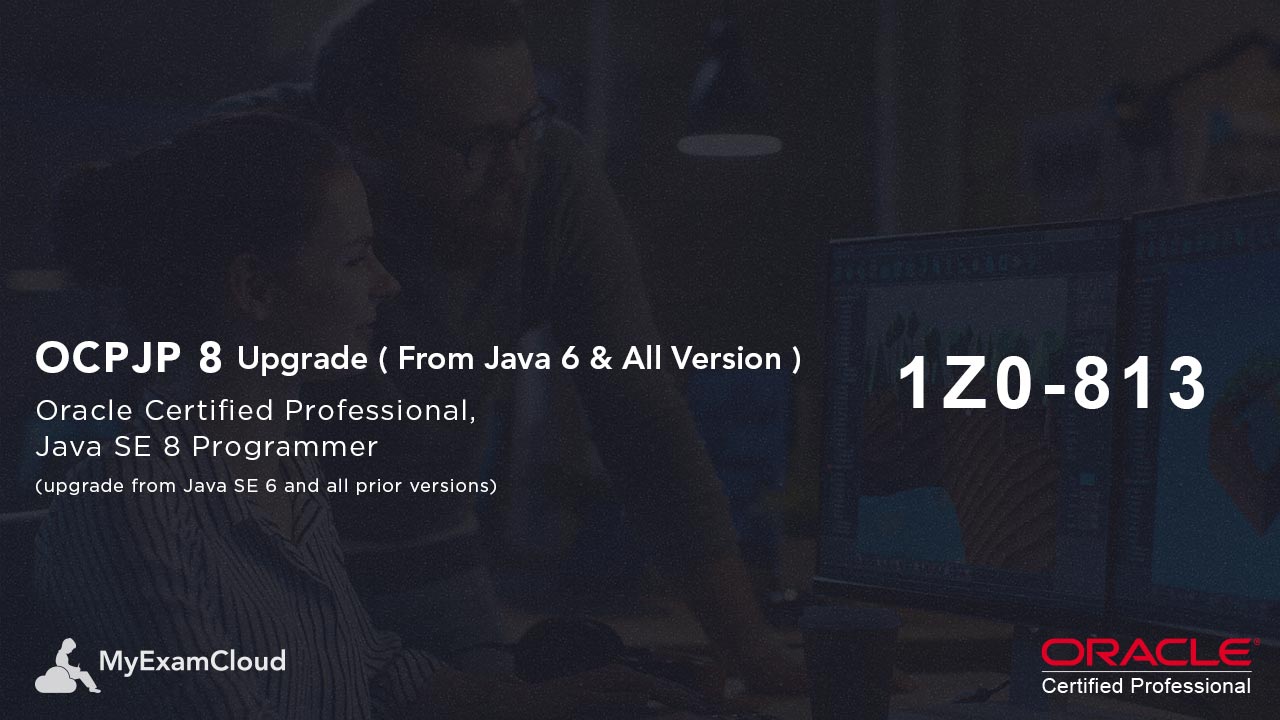
Certification Overview
The OCPJP 8 Upgrade (From Java SE 6 and All Prior Versions) - Oracle Certified Professional, Java SE 8 Programmer (Java SE 6 and all prior versions) certification improves object-orientated programming and Java fundamental skills. This Java Certification also tests Java SE 8 new features such as 'Lambda expressions', 'Streams', 'Concurrenyc' and 'Date and Time API'. As Java Language Specification has been updated for these new features, the experienced Java developers also need to learn the new style of coding by preparing for this exam.
Few important changes of Java SE 8 are:
Lambda Expressions, a new language feature, has been introduced in this release. They enable you to treat functionality as a method argument, or code as data. Lambda expressions let you express instances of single-method interfaces (referred to as functional interfaces) more compactly.
Method references provide easy-to-read lambda expressions for methods that already have a name.
Default methods enable new functionality to be added to the interfaces of libraries and ensure binary compatibility with code written for older versions of those interfaces
Classes in the new java.util.stream package provide a Stream API to support functional-style operations on streams of elements. The Stream API is integrated into the Collections API, which enables bulk operations on collections, such as sequential or parallel map-reduce transformations.
Classes and interfaces have been added to the java.util.concurrent package.
Methods have been added to the java.util.concurrent.ConcurrentHashMap class to support aggregate operations based on the newly added streams facility and lambda expressions.
Classes have been added to the java.util.concurrent.atomic package to support scalable updatable variables.
Methods have been added to the java.util.concurrent.ForkJoinPool class to support a common pool.
The java.util.concurrent.locks.StampedLock class has been added to provide a capability-based lock with three modes for controlling read/write access.
Certification Process
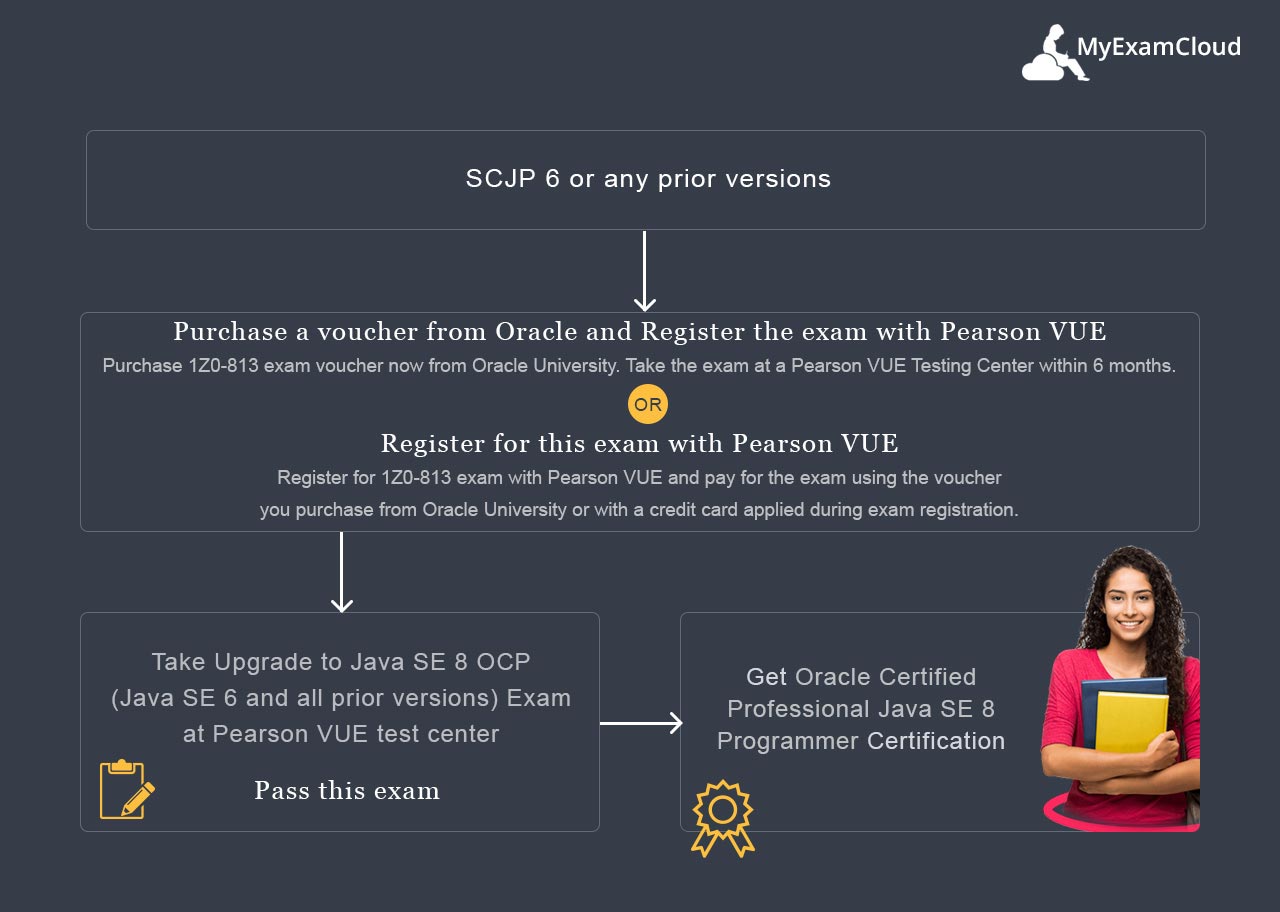
Exam Details
| Exam Number | 1Z0-813 |
|---|---|
| Exam Title | Upgrade to Java SE 8 OCP (Java SE 6 and all prior versions) |
| Exam Duration | 130 minutes |
| Number of Questions | 60 |
| Passing Score | 63% |
| Validated Against | SE 8 |
| Format | Multiple Choice |
Syllabus
Language Enhancements
- Develop code that uses String objects in the switch statement, binary literals, and numeric literals, including underscores in literals
- Develop code that uses try-with-resources statements, including using classes that implement the AutoCloseable interface
- Develop code that handles multiple Exception types in a single catch block
- Use static and default methods of an interface including inheritance rules for a default method
Concurrency
- Use classes from the java.util.concurrent package including CyclicBarrier and CopyOnWriteArrayList with a focus on the advantages over and differences from the traditional java.util collections
- Use Lock, ReadWriteLock, and ReentrantLock classes in the java.util.concurrent.locks and java.util.concurrent.atomic packages to support lock-free thread-safe programming on single variables
- Use Executor, ExecutorService, Executors, Callable, and Future to execute tasks using thread pools
- Use the parallel Fork/Join Framework
Localization
- Describe the advantages of localizing an application and developing code that defines, reads, and sets the locale with a Locale object
- Build a resource bundle for a locale and call a resource bundle from an application
- Create and manage date- and time-based events by using LocalDate, LocalTime, LocalDateTime, Instant, Period, and Duration, including a combination of date and time in a single object
- Format dates, numbers, and currency values for localization with the NumberFormat and DateFormat classes, including number and date format patterns
- Work with dates and times across time zones and manage changes resulting from daylight savings
Java File I/O (NIO.2)
- Operate on file and directory paths by using the Paths class
- Check, delete, copy, or move a file or directory by using the Files class
- Recursively access a directory tree by using the DirectoryStream and FileVisitor interfaces
- Find a file by using the PathMatcher interface, and use Java SE 8 I/O improvements, including Files.find(), Files.walk(), and lines() methods
- Observe the changes in a directory by using the WatchService interface
Lambda
- Define and write functional interfaces and describe the interfaces of the java.util.function package
- Describe a lambda expression; refactor the code that uses an anonymous inner class to use a lambda expression; describe type inference and target typing
- Develop code that uses the built-in interfaces included in the java.util.function package, such as Function, Consumer, Supplier, UnaryOperator, Predicate, and Optional APIs, including the primitive and binary variations of the interfaces
- Develop code that uses a method reference, including refactoring a lambda expression to a method reference
Java Collections
- Develop code that uses diamond with generic declarations
- Develop code that iterates a collection, filters a collection, and sorts a collection by using lambda expressions
- Search for data by using methods, such as findFirst(), findAny(), anyMatch(), allMatch(), and noneMatch()
- Perform calculations on Java Streams by using count, max, min, average, and sum methods and save results to a collection by using the collect method and Collector class, including the averagingDouble, groupingBy, joining, partitioningBy methods
- Develop code that uses Java SE 8 collection improvements, including the Collection.removeIf(), List.replaceAll(), Map.computeIfAbsent(), and Map.computeIfPresent() methods
- Develop code that uses the merge(), flatMap(), and map() methods on Java Streams
Java Streams
- Describe the Stream interface and pipelines; create a stream by using the Arrays.stream() and IntStream.range() methods; identify the lambda operations that are lazy
- Develop code that uses parallel streams, including decomposition operation and reduction operation in streams
Preparation
Sample content for preparation. Sample content for preparation. Sample content for preparation. Sample content for preparation.
Who can take this certification?
Set The New Java Standard With Java SE 8 OCA Certification Java SE 8 significantly changes the way you write code. Java SE 8 Certification gives you the tools to make the most of new features. The Java SE 8 Oracle Certified Associate (OCA) certification provides a foundational understanding of Java as well as programming in general. So it suits for most Java Professionals starting from beginner to expert.
- College Students
- Java Developer looking for Job
- Java Trainers
- Java Developers
Benifits
The reason for taking Oracle Java Certification is to differentiate general programmers from certified experts. You may get additional benefits like getting a good job, salary hike, designation changes, role changes and higher promotion.
Stand out from the millions of Java crowd. Increase your marketability with OCPJP 7 Upgrade Certification on the most used programming language in the world - Java.
Related Articles: https://www.epractizelabs.com/myexamcloud/2017/04/20/oracle-java-certification-exam-preparation/
Success Story
Thanh son Le
I found the Training Lab Exams to be fantastic! The questions were more intense than the actual exams. It has become a common practice for the training staff at our company to recommend your products. Thanks!
Oracle Certified Professional, Java SE 8 Programmer (Upgrade from Java SE 7)
Learn More StudyPlan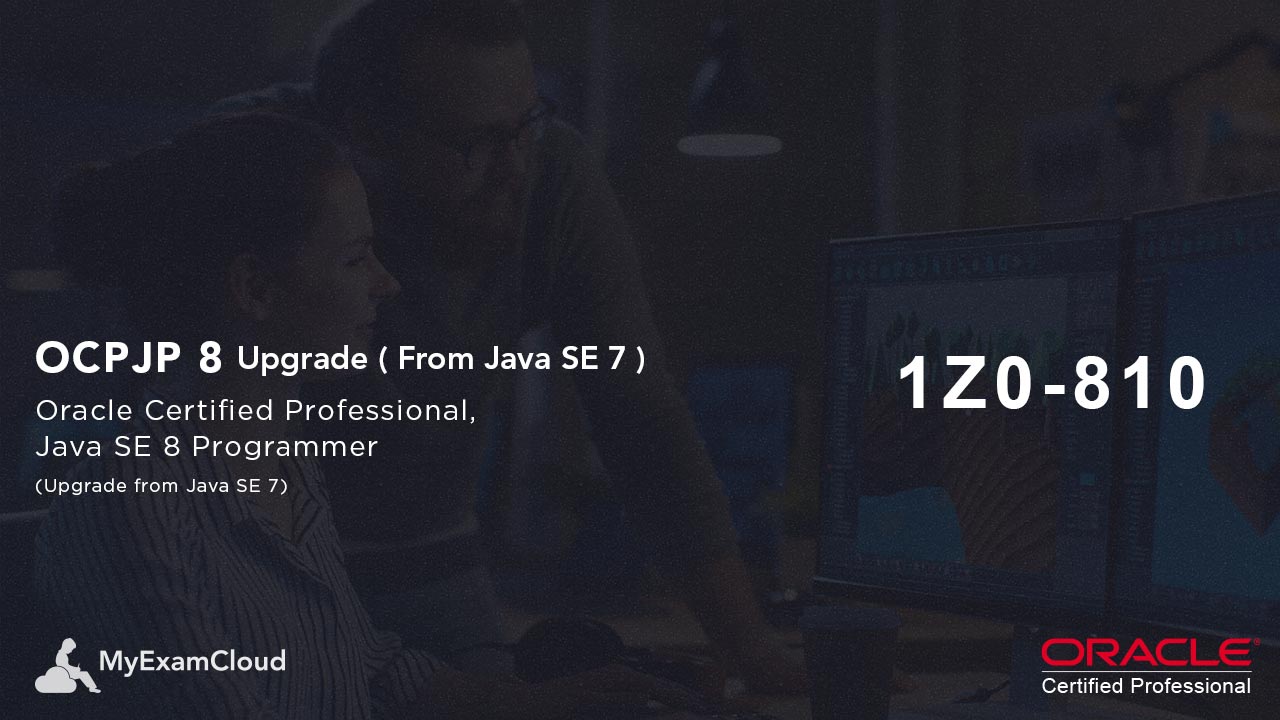
Certification Overview
The OCPJP 8 Upgrade - (Oracle Certified Professional, Java SE 8 Programmer (upgrade) certification improves object-orientated programming and Java fundamental skills. This Java certification also tests Java SE 8 new features such as 'Lambda expressions', 'Streams', 'Concurrenyc' and 'Date and Time API'. As Java Language Specification has been updated for these new features, the experienced Java developers also need to learn the new style of coding by preparing for this exam.
Few important changes of Java SE 8 are:
Lambda Expressions, a new language feature, has been introduced in this release. They enable you to treat functionality as a method argument, or code as data. Lambda expressions let you express instances of single-method interfaces (referred to as functional interfaces) more compactly.
Method references provide easy-to-read lambda expressions for methods that already have a name.
Default methods enable new functionality to be added to the interfaces of libraries and ensure binary compatibility with code written for older versions of those interfaces
Classes in the new java.util.stream package provide a Stream API to support functional-style operations on streams of elements. The Stream API is integrated into the Collections API, which enables bulk operations on collections, such as sequential or parallel map-reduce transformations.
Classes and interfaces have been added to the java.util.concurrent package.
Methods have been added to the java.util.concurrent.ConcurrentHashMap class to support aggregate operations based on the newly added streams facility and lambda expressions.
Classes have been added to the java.util.concurrent.atomic package to support scalable updatable variables.
Methods have been added to the java.util.concurrent.ForkJoinPool class to support a common pool.
The java.util.concurrent.locks.StampedLock class has been added to provide a capability-based lock with three modes for controlling read/write access.
Certification Process
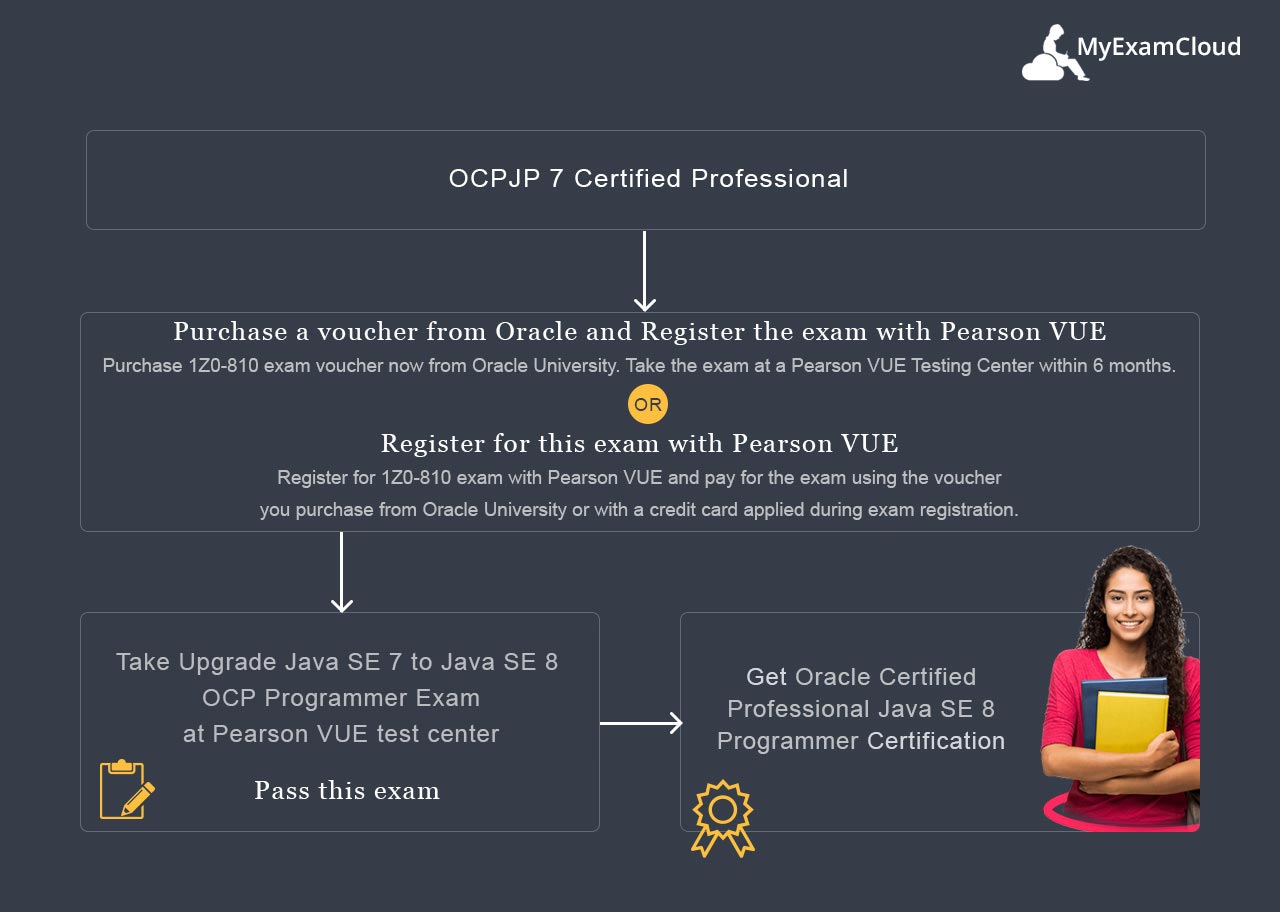
Exam Details
| Exam Number | 1Z0-810 |
|---|---|
| Exam Name | Upgrade Java SE 7 to Java SE 8 OCP Programmer |
| Duration | 150 minutes |
| Number of Questions | 60 |
| Passing Score | 65% |
| Validated Against | Java SE 8 |
| Format | Multiple Choice |
Syllabus
Lambda Expressions
- Describe and develop code that uses Java inner classes, including nested class, static class, local class, and anonymous classes
- Describe and write functional interfaces
- Describe a lambda expression; refactor the code that uses an anonymous inner class to use a lambda expression; describe type inference and target typing
Using Built-in Lambda Types
- Describe the interfaces of the java.util.function package
- Develop code that uses the Function interface
- Develop code that uses the Consumer interface
- Develop code that uses the Supplier interface
- Develop code that uses the UnaryOperator interface
- Develop code that uses the Predicate interface
- Develop code that uses the primitive and binary variations of the base interfaces of the java.util.function package
- Develop code that uses a method reference, including refactoring a lambda expression to a method reference
Java Collections and Streams with Lambdas
- Develop code that iterates a collection by using the forEach() method and method chaining
- Describe the Stream interface and pipelines
- Filter a collection by using lambda expressions
- Identify the operations, on stream, that are lazy
Collection Operations with Lambda
- Develop code to extract data from an object by using the map() method
- Search for data by using methods such as findFirst(), findAny(), anyMatch(), allMatch(), and noneMatch()
- Describe the unique characteristics of the Optional class
- Perform calculations by using Java Stream methods, such as count(), max(), min(), average(), and sum()
- Sort a collection by using lambda expressions
- Develop code that uses the Stream.collect() method and Collectors class methods, such as averagingDouble(), groupingBy(), joining(), and partitioningBy()
Parallel Streams
- Develop code that uses parallel streams
- Implement decomposition and reduction in streams
Lambda Cookbook
- Develop code that uses Java SE 8 collection improvements, including Collection.removeIf(), List.replaceAll(), Map.computeIfAbsent(), and Map.computeIfPresent() methods
- Develop code that uses Java SE 8 I/O improvements, including Files.find(), Files.walk(), and lines() methods
- Use flatMap() methods in the Stream API
- Develop code that creates a stream by using the Arrays.stream() and IntStream.range() methods
Method Enhancements
- Add static methods to interfaces
- Define and use a default method of an interface and describe the inheritance rules for the default method
Use Java SE 8 Date/Time API
- Create and manage date- and time-based events, including a combination of date and time in a single object, by using LocalDate, LocalTime, LocalDateTime, Instant, Period, and Duration
- Work with dates and times across time zones and manage changes resulting from daylight savings, including Format date and times values
- Define, create, and manage date- and time-based events using Instant, Period, Duration, and TemporalUnit
Preparation
Sample content for preparation. Sample content for preparation. Sample content for preparation. Sample content for preparation.
Who can take this certification?
Set The New Java Standard With Java SE 8 OCA Certification Java SE 8 significantly changes the way you write code. Java SE 8 Certification gives you the tools to make the most of new features. The Java SE 8 Oracle Certified Associate (OCA) certification provides a foundational understanding of Java as well as programming in general. So it suits for most Java Professionals starting from beginner to expert.
- College Students
- Java Developer looking for Job
- Java Trainers
- Java Developers
Benifits
The reason for taking Oracle Java Certification is to differentiate general programmers from certified experts. You may get additional benefits like getting a good job, salary hike, designation changes, role changes and higher promotion.
Stand out from the millions of Java crowd. Increase your marketability with OCPJP 7 Upgrade Certification on the most used programming language in the world - Java.
Related Articles: https://www.epractizelabs.com/myexamcloud/2017/04/20/oracle-java-certification-exam-preparation/
Success Story
Thanh son Le
I found the Training Lab Exams to be fantastic! The questions were more intense than the actual exams. It has become a common practice for the training staff at our company to recommend your products. Thanks!
Oracle Certified Professional, Java SE 7 Programmer
Learn More StudyPlan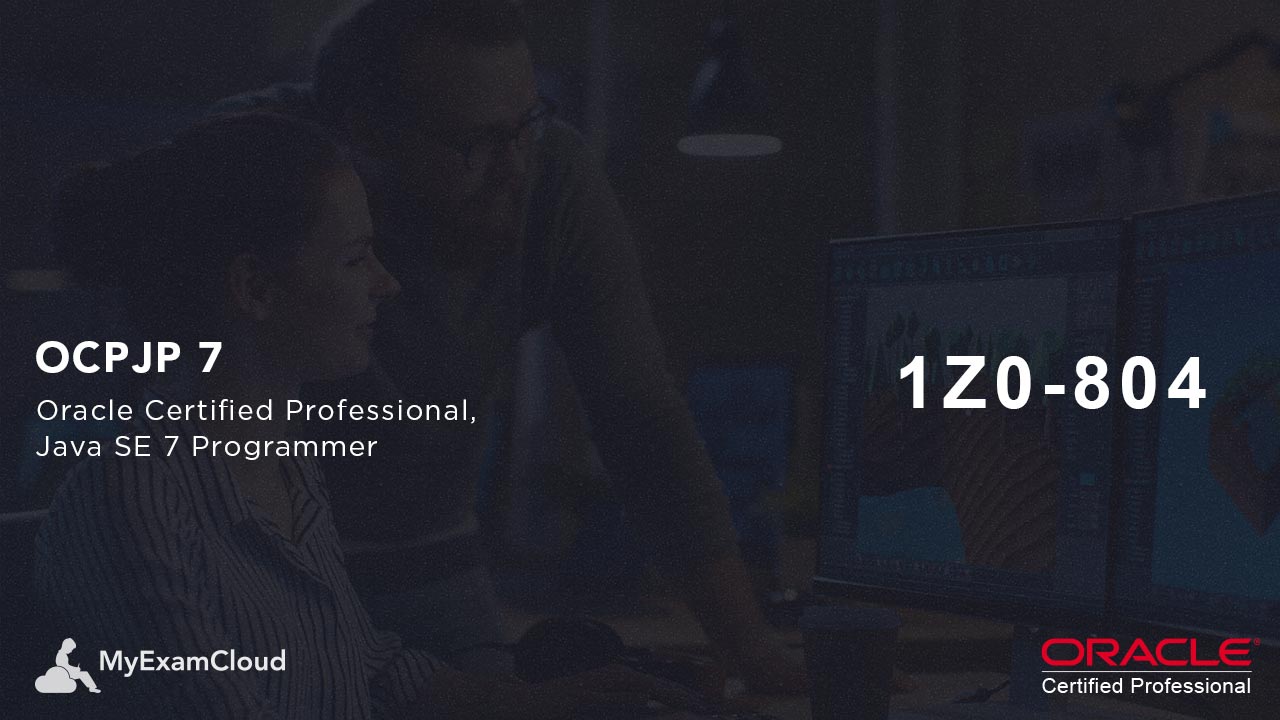
Certification Overview
The OCPJP 7 (Oracle Certified Professional, Java SE 7 Programmer) certification improves object-orientated programming and Java fundamental skills. This Java Certification also tests few Java SE 7 new features.
Binary Literals - In Java SE 7, the integral types (byte, short, int, and long) can also be expressed using the binary number system. To specify a binary literal, add the prefix 0b or 0B to the number.
Underscores in Numeric Literals - Any number of underscore characters (_) can appear anywhere between digits in a numerical literal. This feature enables you, for example, to separate groups of digits in numeric literals, which can improve the readability of your code.
Strings in switch Statements - You can use the String class in the expression of a switch statement.
Type Inference for Generic Instance Creation - You can replace the type arguments required to invoke the constructor of a generic class with an empty set of type parameters (< >) as long as the compiler can infer the type arguments from the context. This pair of angle brackets is informally called the diamond.
The try-with-resources Statement - The try-with-resources statement is a try statement that declares one or more resources. A resource is an object that must be closed after the program is finished with it.
The try-with-resources statement ensures that each resource is closed at the end of the statement. Any object that implements the new java.lang.AutoCloseable interface or the java.io.Closeable interface can be used as a resource. The classes java.io.InputStream, OutputStream, Reader, Writer, java.sql.Connection, Statement, and ResultSet have been retrofitted to implement the AutoCloseable interface and can all be used as resources in a try-with-resources statement.
Catching Multiple Exception Types and Re-throwing Exceptions with Improved Type Checking - A single catch block
Certification Process
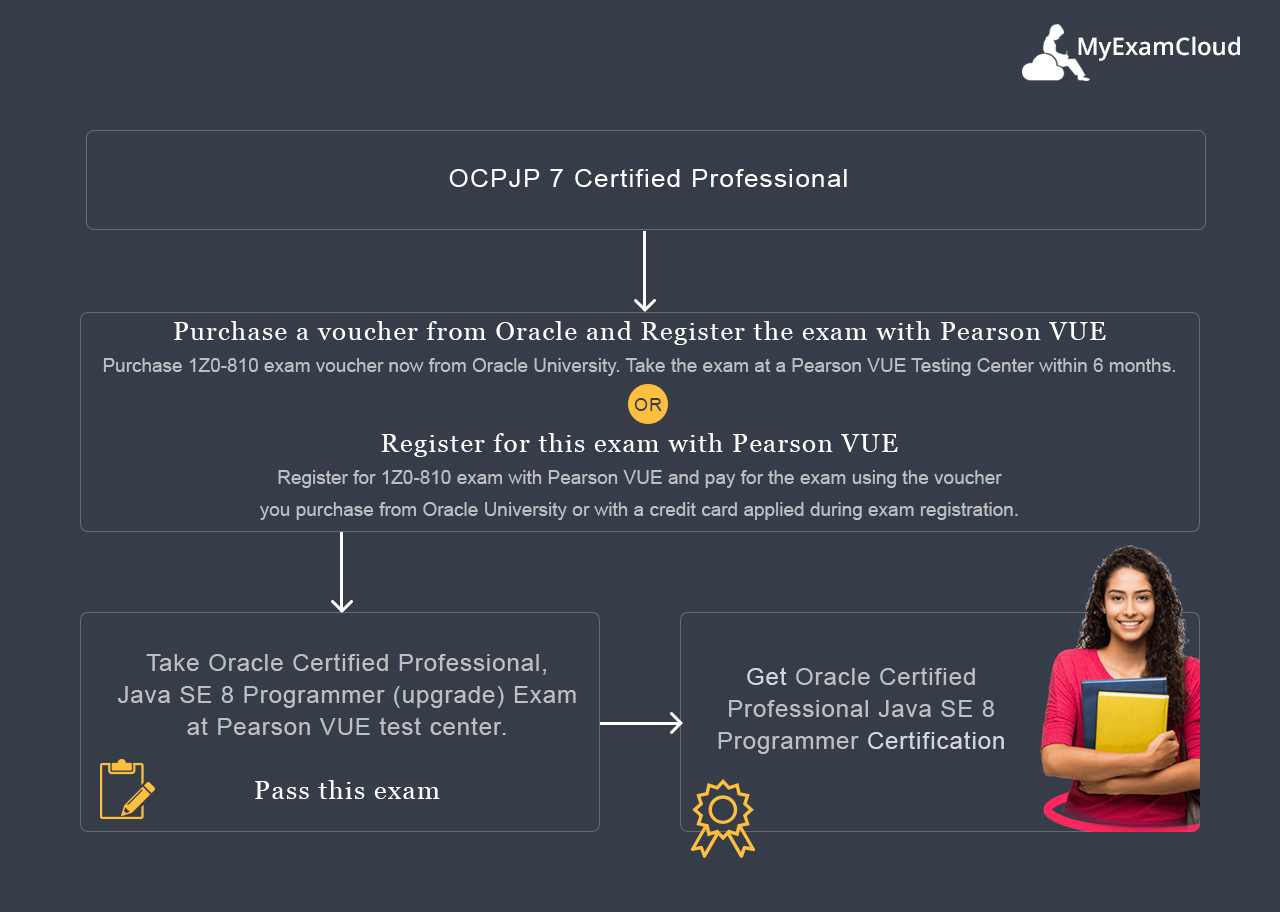
Exam Details
| Exam Number | 1Z0-804 |
|---|---|
| Exam Name | Java SE 7 Programmer II |
| Exam Duration | 150 minutes |
| Number of Questions | 65 |
| Passing Score | 65% |
| Validated Against | SE 7 |
| Format | Multiple Choice |
Syllabus
Lambda Expressions
- Describe and develop code that uses Java inner classes, including nested class, static class, local class, and anonymous classes
- Describe and write functional interfaces
- Describe a lambda expression; refactor the code that uses an anonymous inner class to use a lambda expression; describe type inference and target typing
Using Built-in Lambda Types
- Describe the interfaces of the java.util.function package
- Develop code that uses the Function interface
- Develop code that uses the Consumer interface
- Develop code that uses the Supplier interface
- Develop code that uses the UnaryOperator interface
- Develop code that uses the Predicate interface
- Develop code that uses the primitive and binary variations of the base interfaces of the java.util.function package
- Develop code that uses a method reference, including refactoring a lambda expression to a method reference
Java Collections and Streams with Lambdas
- Develop code that iterates a collection by using the forEach() method and method chaining
- Describe the Stream interface and pipelines
- Filter a collection by using lambda expressions
- Identify the operations, on stream, that are lazy
Collection Operations with Lambda
- Develop code to extract data from an object by using the map() method
- Search for data by using methods such as findFirst(), findAny(), anyMatch(), allMatch(), and noneMatch()
- Describe the unique characteristics of the Optional class
- Perform calculations by using Java Stream methods, such as count(), max(), min(), average(), and sum()
- Sort a collection by using lambda expressions
- Develop code that uses the Stream.collect() method and Collectors class methods, such as averagingDouble(), groupingBy(), joining(), and partitioningBy()
Parallel Streams
- Develop code that uses parallel streams
- Implement decomposition and reduction in streams
Lambda Cookbook
- Develop code that uses Java SE 8 collection improvements, including Collection.removeIf(), List.replaceAll(), Map.computeIfAbsent(), and Map.computeIfPresent() methods
- Develop code that uses Java SE 8 I/O improvements, including Files.find(), Files.walk(), and lines() methods
- Use flatMap() methods in the Stream API
- Develop code that creates a stream by using the Arrays.stream() and IntStream.range() methods
Method Enhancements
- Add static methods to interfaces
- Define and use a default method of an interface and describe the inheritance rules for the default method
Use Java SE 8 Date/Time API
- Create and manage date- and time-based events, including a combination of date and time in a single object, by using LocalDate, LocalTime, LocalDateTime, Instant, Period, and Duration
- Work with dates and times across time zones and manage changes resulting from daylight savings, including Format date and times values
- Define, create, and manage date- and time-based events using Instant, Period, Duration, and TemporalUnit
Preparation
Sample content for preparation. Sample content for preparation. Sample content for preparation. Sample content for preparation.
Who can take this certification?
Set The New Java Standard With Java SE 8 OCA Certification Java SE 8 significantly changes the way you write code. Java SE 8 Certification gives you the tools to make the most of new features. The Java SE 8 Oracle Certified Associate (OCA) certification provides a foundational understanding of Java as well as programming in general. So it suits for most Java Professionals starting from beginner to expert.
- College Students
- Java Developer looking for Job
- Java Trainers
- Java Developers
Benifits
The reason for taking Oracle Java Certification is to differentiate general programmers from certified experts. You may get additional benefits like getting a good job, salary hike, designation changes, role changes and higher promotion.
Stand out from the millions of Java crowd. Increase your marketability with OCPJP 7 Upgrade Certification on the most used programming language in the world - Java.
Related Articles: https://www.epractizelabs.com/myexamcloud/2017/04/20/oracle-java-certification-exam-preparation/
Success Story
Thanh son Le
I found the Training Lab Exams to be fantastic! The questions were more intense than the actual exams. It has become a common practice for the training staff at our company to recommend your products. Thanks!
Oracle Certified Professional, Java SE 7 Programmer (upgrade)
Learn More StudyPlan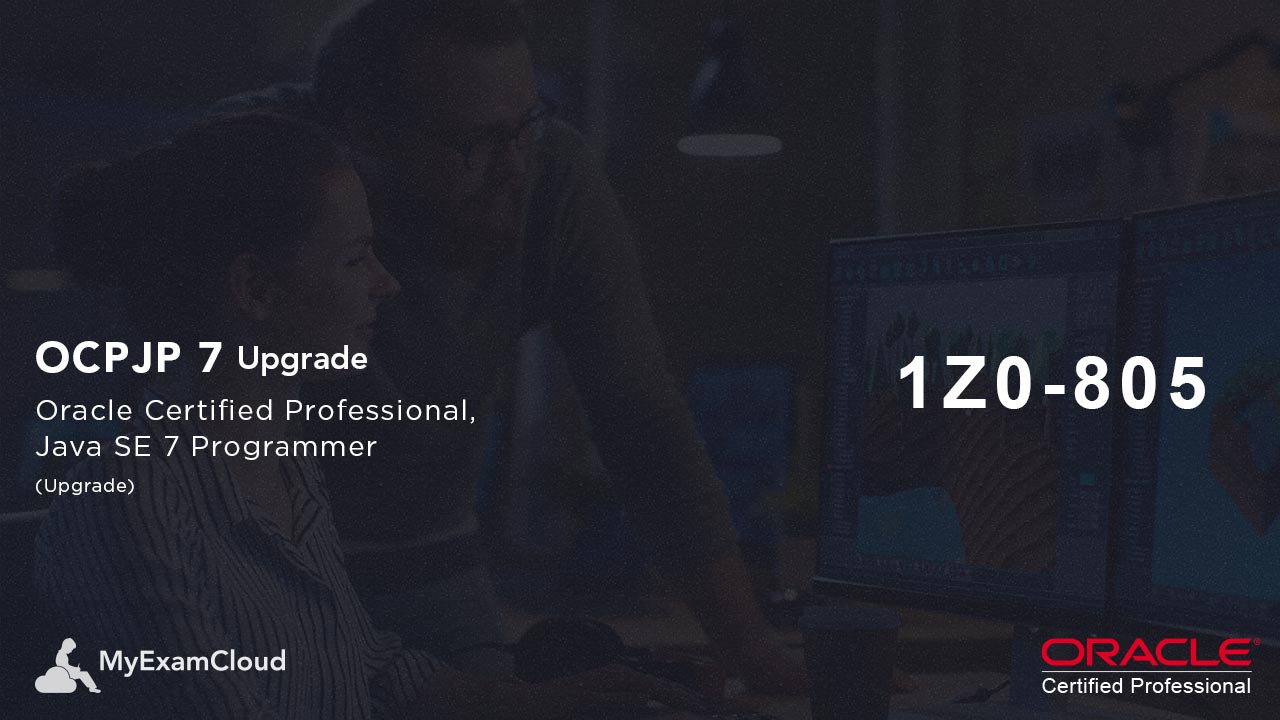
Certification Overview
The OCPJP 7 Upgrade (Oracle Certified Professional, Java SE 7 Programmer Upgrade) certification improves object-orientated programming and Java fundamental skills. This Java Certification also tests few Java SE 7 new features.
Binary Literals - In Java SE 7, the integral types (byte, short, int, and long) can also be expressed using the binary number system. To specify a binary literal, add the prefix 0b or 0B to the number.
Underscores in Numeric Literals - Any number of underscore characters (_) can appear anywhere between digits in a numerical literal. This feature enables you, for example, to separate groups of digits in numeric literals, which can improve the readability of your code.
Strings in switch Statements - You can use the String class in the expression of a switch statement.
Type Inference for Generic Instance Creation - You can replace the type arguments required to invoke the constructor of a generic class with an empty set of type parameters (< >) as long as the compiler can infer the type arguments from the context. This pair of angle brackets is informally called the diamond.
The try-with-resources Statement - The try-with-resources statement is a try statement that declares one or more resources. A resource is an object that must be closed after the program is finished with it.
The try-with-resources statement ensures that each resource is closed at the end of the statement. Any object that implements the new java.lang.AutoCloseable interface or the java.io.Closeable interface can be used as a resource. The classes java.io.InputStream, OutputStream, Reader, Writer, java.sql.Connection, Statement, and ResultSet have been retrofitted to implement the AutoCloseable interface and can all be used as resources in a try-with-resources statement.
Catching Multiple Exception Types and Re-throwing Exceptions with Improved Type Checking - A single catch block
Certification Process
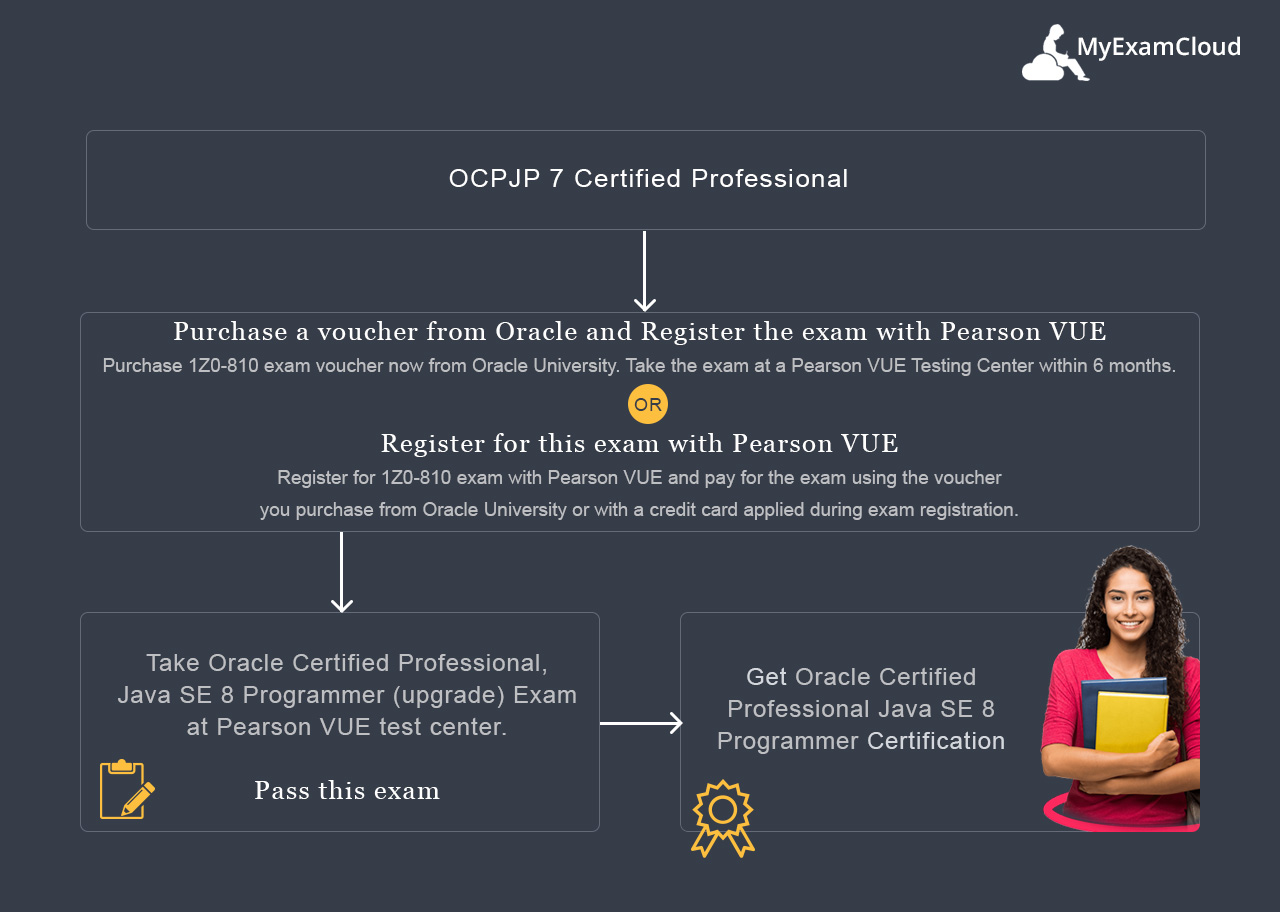
Exam Details
| Exam Number | 1Z0-805 |
|---|---|
| Exam Title | Upgrade to Java SE 7 Programmer |
| Exam Duration | 150 minutes |
| Number of Questions | 70 |
| Passing Score | 60% |
| Validated Against | SE 7 |
| Format | Multiple Choice |
Syllabus
Lambda Expressions
- Describe and develop code that uses Java inner classes, including nested class, static class, local class, and anonymous classes
- Describe and write functional interfaces
- Describe a lambda expression; refactor the code that uses an anonymous inner class to use a lambda expression; describe type inference and target typing
Using Built-in Lambda Types
- Describe the interfaces of the java.util.function package
- Develop code that uses the Function interface
- Develop code that uses the Consumer interface
- Develop code that uses the Supplier interface
- Develop code that uses the UnaryOperator interface
- Develop code that uses the Predicate interface
- Develop code that uses the primitive and binary variations of the base interfaces of the java.util.function package
- Develop code that uses a method reference, including refactoring a lambda expression to a method reference
Java Collections and Streams with Lambdas
- Develop code that iterates a collection by using the forEach() method and method chaining
- Describe the Stream interface and pipelines
- Filter a collection by using lambda expressions
- Identify the operations, on stream, that are lazy
Collection Operations with Lambda
- Develop code to extract data from an object by using the map() method
- Search for data by using methods such as findFirst(), findAny(), anyMatch(), allMatch(), and noneMatch()
- Describe the unique characteristics of the Optional class
- Perform calculations by using Java Stream methods, such as count(), max(), min(), average(), and sum()
- Sort a collection by using lambda expressions
- Develop code that uses the Stream.collect() method and Collectors class methods, such as averagingDouble(), groupingBy(), joining(), and partitioningBy()
Parallel Streams
- Develop code that uses parallel streams
- Implement decomposition and reduction in streams
Lambda Cookbook
- Develop code that uses Java SE 8 collection improvements, including Collection.removeIf(), List.replaceAll(), Map.computeIfAbsent(), and Map.computeIfPresent() methods
- Develop code that uses Java SE 8 I/O improvements, including Files.find(), Files.walk(), and lines() methods
- Use flatMap() methods in the Stream API
- Develop code that creates a stream by using the Arrays.stream() and IntStream.range() methods
Method Enhancements
- Add static methods to interfaces
- Define and use a default method of an interface and describe the inheritance rules for the default method
Use Java SE 8 Date/Time API
- Create and manage date- and time-based events, including a combination of date and time in a single object, by using LocalDate, LocalTime, LocalDateTime, Instant, Period, and Duration
- Work with dates and times across time zones and manage changes resulting from daylight savings, including Format date and times values
- Define, create, and manage date- and time-based events using Instant, Period, Duration, and TemporalUnit
Preparation
Sample content for preparation. Sample content for preparation. Sample content for preparation. Sample content for preparation.
Who can take this certification?
Set The New Java Standard With Java SE 8 OCA Certification Java SE 8 significantly changes the way you write code. Java SE 8 Certification gives you the tools to make the most of new features. The Java SE 8 Oracle Certified Associate (OCA) certification provides a foundational understanding of Java as well as programming in general. So it suits for most Java Professionals starting from beginner to expert.
- College Students
- Java Developer looking for Job
- Java Trainers
- Java Developers
Benifits
The reason for taking Oracle Java Certification is to differentiate general programmers from certified experts. You may get additional benefits like getting a good job, salary hike, designation changes, role changes and higher promotion.
Stand out from the millions of Java crowd. Increase your marketability with OCPJP 7 Upgrade Certification on the most used programming language in the world - Java.
Related Articles: https://www.epractizelabs.com/myexamcloud/2017/04/20/oracle-java-certification-exam-preparation/
Success Story
Thanh son Le
I found the Training Lab Exams to be fantastic! The questions were more intense than the actual exams. It has become a common practice for the training staff at our company to recommend your products. Thanks!
Expert Level
Java EE Expert Certification
Oracle Certified Expert, Java EE 6 JavaServer Faces Developer
Learn More StudyPlan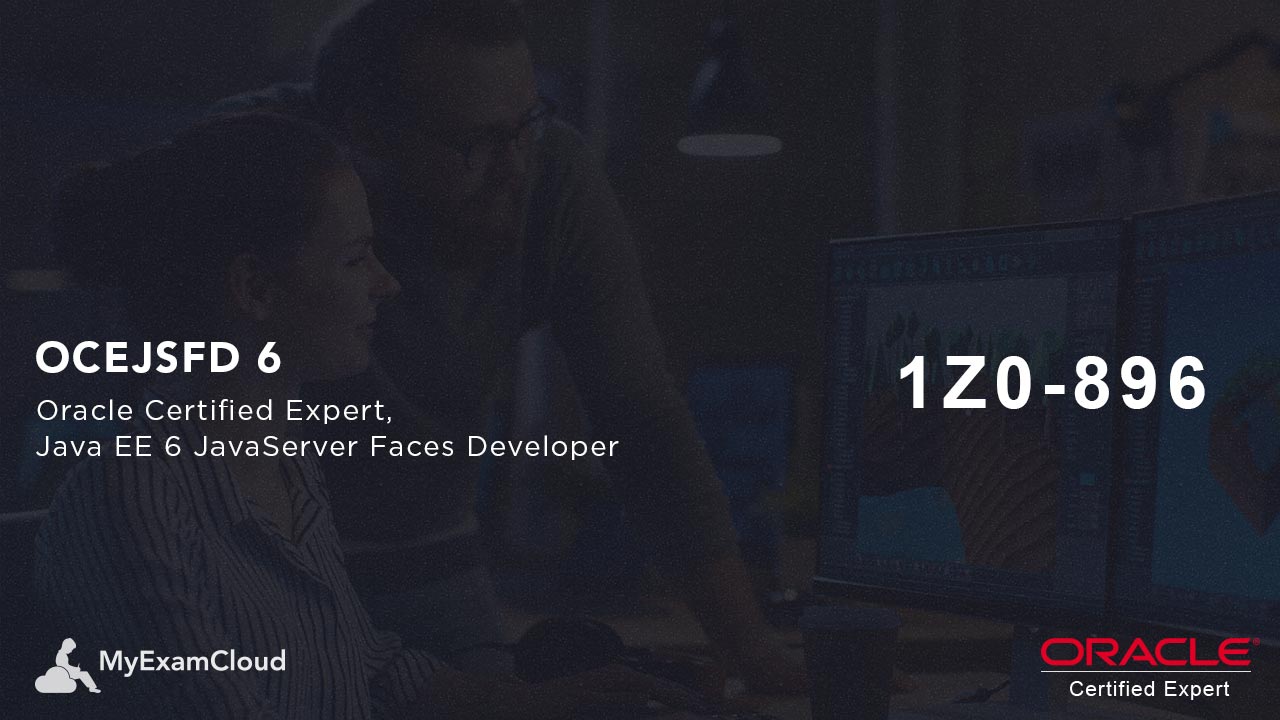
Certification Overview
The OCEJSFD 6 (Oracle Certified Expert, EE 6 JavaServer Faces Developer) certification improves JavaServer Faces web application framework technology design and development skills. This Java Certification tests Java EE 6 JSF key concepts, design, page templates, custom & composite components using Facelets, CDI beans, data conversion & validation, event handling and AJAX integration with custom components. Java EE 6 specification has been updated for these new features, so the experienced Java EE developers also need to learn this new changes by preparing for this exam.
Certification Process
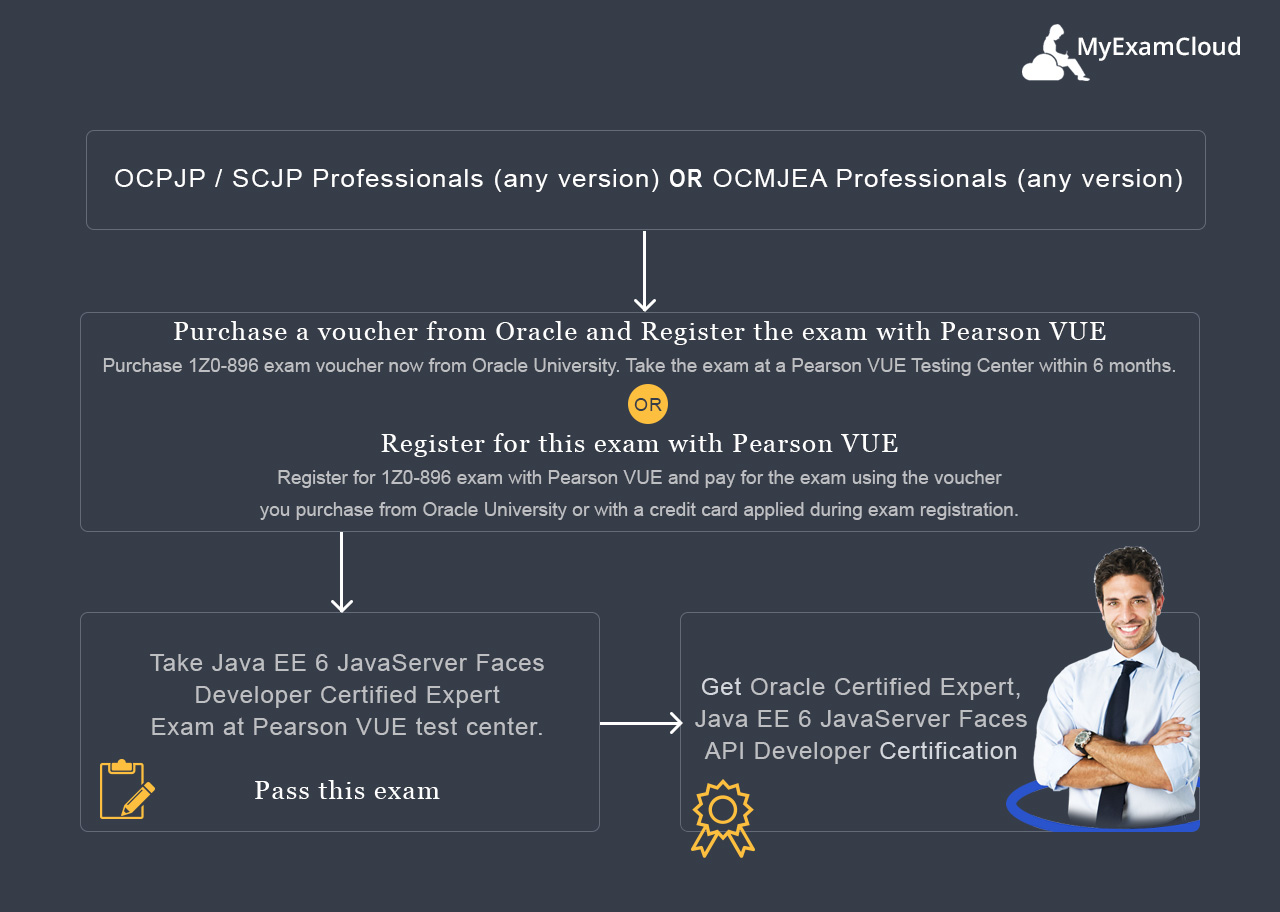
Exam Details
| Exam Number | 1Z0-896 |
|---|---|
| Exam Title | Java EE 6 JavaServer Faces Developer |
| Exam Duration | 150 minutes |
| Number of Questions | 87 |
| Passing Score | 70% |
| Validated Against | EE 6 |
| Format | Multiple Choice |
Syllabus
Section 1: Essentials of JSF2.0
- Identify the features of JSF such as Facelets, BookMarkable View, AJAX support and the benefits they bring in
- Identify the life cycle stages of JSF, flow of request processing, and purpose of FacesContext
- Design XHTML pages using JSF HTML tag library and demonstrate usage of JSF implicit objects
- Develop and associate model components with views using CDI Named beans and identify the advantages of CDI Named beans over Managed Bean
- Manage user and application state using various scopes like flash, conversation, application, request, and session
- Implement internationalization/Localization using resource bundle and Locale class
Section 2: JSF Navigation Model
- Design JSF pages with static and dynamic implicit navigation
- Configure faces-config.xml to implement navigation rules including conditional and redirection
- Design bookmarkable views
Section 3: Data Conversion and Validation model
- Implement data conversion model using JSF standard converters
- Create, configure, and use custom converters
- Identify the best suited standard validator and implement it in a given JSF application
- Create, configure, and use custom validators
- Describe the usage of bean validation
Section 4: Event Handling
- Use CDI Named bean in a JSF application to handle action and valuechange events
- Create and implement listeners to handle events
- Develop JSF application that handle life cycle events
- Implement asynchronous events using AJAX
Section 5: Data table and Composite Components
- Design a DataTable with header and footer to populate and manipulate data from various components like Array, List, ResultSet, DataModel and describe the differences between <f:dataTable> and <ui:repeat/>
- Implement composite components in JSF application and enhance it using AJAX
- Implement templates in a JSF application and describe the differences between <ui:composition/> and <ui:decorate/>
Section 6: Custom Components
- Identify when and how to use custom components and custom renderers.
- Enhance JSF application using HTML5 components
Section 7: Security
- Configure security for JSF application using authorization and authentication techniques
Section 8: Test, Package, and Deploy a web application
- Implement efficient error handling and debugging techniques in a JSF application
- Configure and deploy a JSF application
Preparation
Sample content for preparation. Sample content for preparation. Sample content for preparation. Sample content for preparation.
Who can take this certification?
This certificate is for those who already have experience working with the Java Enterprise Edition front end and who, ideally, also has experience with developing web applications. If you’re an Application Development Framework developer, you will also have the skills to make the jump to getting certified in this technology.
Earning this certification makes it possible to create feature-rich and cohesive user interfaces and removes the need for collaboration with web designers and developers. Earning this certificate not only expands your skills repertoire, but it also can give you a competitive edge over others in the job market and opens the door to a variety of career opportunities.
The exam covers the following topics: Essentials of JSF2.0, JSF navigation model, Data conversion and validation model, event handling, data table and composite components, custom components, security, and test, package and deploy a web application.
Set The New Java Standard With Java EE 6 JSF Certification: Java EE 6 significantly changes the web tier components, WAF (Web Application Framework) and APIs. Java EE 6 JSF Certification gives you the tools to make the most of new features. The Java EE 6 Oracle Certified Expert (OCE) JSF Certification provides a foundational understanding of Java EE web Tier as well as MVC programming in general. So it suits for most Java EE Professionals starting from beginner to expert.
- Java EE Aspirants
- Java EE Developer looking for Job
- Java EE Trainers
Benifits
The reason for taking Oracle Java Certification is to differentiate general programmers from certified experts. You may get additional benefits like getting a good job, salary hike, designation changes, role changes and higher promotion.
Stand out from the millions of Java crowd. Increase your marketability with OCEJSFD 6 Certification on the most used programming language in the world - Java.
The JSF certified professional can be able to design web applications using standard architectures, protocols, technologies and components as well as configure JSF within the Web Container. These professionals will have a working knowledge of how to design views using JSF and ES, custom components using Facelets and design and develop the model using JavaBeans or Pojos. They should also be able to integrate external resources, navigation flow/redirection, models and views using events and security.
Success Story
Thanh son Le
I found the Training Lab Exams to be fantastic! The questions were more intense than the actual exams. It has become a common practice for the training staff at our company to recommend your products. Thanks!
Oracle Certified Expert, Java EE 6 Web Component Developer
Learn More StudyPlan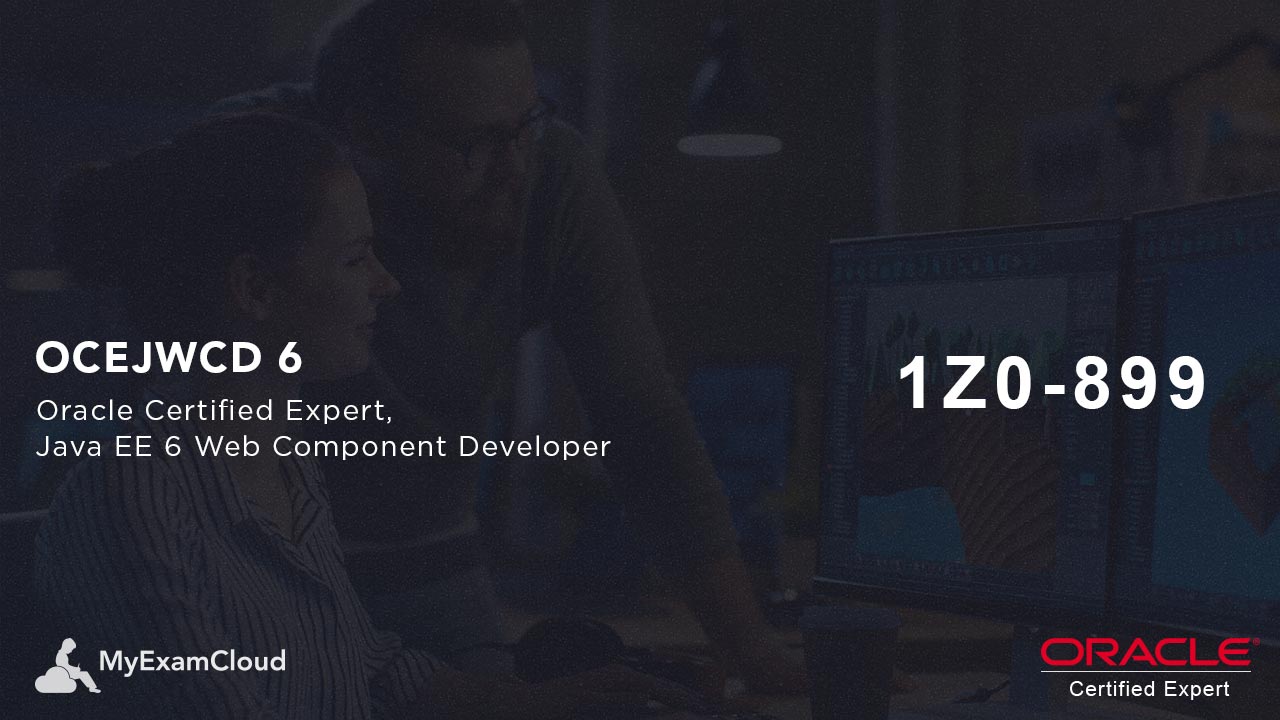
Certification Overview
This certification is designed for experienced Java technology application developers. Those seeking certification should already have the skills and understanding of how to efficiently build web applications suited to any Java EE 6 application server using JSP and servlet technologies.
Candidates should be familiar with the most up to date methods for analysing, designing, creating, and deploying web applications using Java technologies. Experience with small-to-medium scale web applications found in intranet and low-volume commercial sites is also advantageous.
The exam covers the following topics: introduction to Java Servlets, introduction to Java Server Pages, implementing an MVC design, the servlet’s environment, container facilities for servlets and JSPs, more view facilities, developing JSP pages, developing JSP pages using custom tags, more Controller facilities, more options for the Model, asynchronous web applications, and web application security.
The OCEJWCD 6 (Oracle Certified Expert, EE 6 Web Component Developer) certification improves Java EE web tier technology components (JSP & Servlets) design and development skills. This Java Certification tests Java EE 6 JSP & Servlet key concepts, annotations, MVC design, EL tags, web.xml improvements, security and deployment. Java EE 6 specification has been updated for these new features, so the experienced Java EE developers also need to learn this new changes by preparing for this exam.
Certification Process
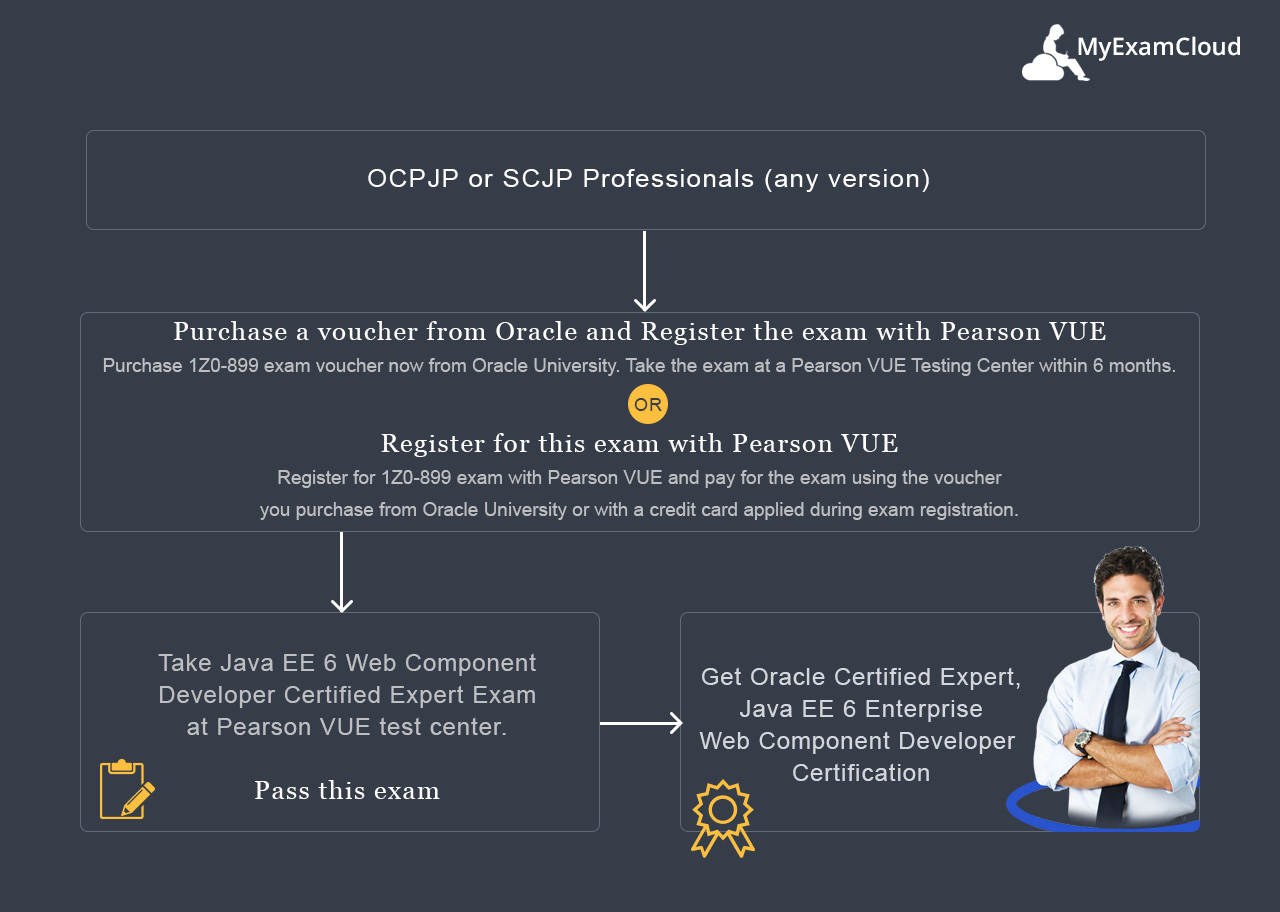
Exam Details
| Exam Number | 1Z0-899 |
|---|---|
| Exam Name | Java EE 6 Web Component Developer Certified Expert |
| Exam Duration | 140 minutes |
| Number of Questions | 57 |
| Passing Score | 64% |
| Validated Against | Java EE 6 |
| Format | Multiple Choice |
Syllabus
Introduction to Java Servlets
- Describe web applications, CGI, and the role of Java
- Describe benefits of Java servlet technology
- Create a simple Java Servlet
- Define three-tier architecture
- Define Model-View-Controller (MVC) architecture
Introduction to Java Server Pages
- Describe why Servlets are not the whole solution
- Describe essentials of JSPs
- Understand the fundamentals and reasons for MVC architecture
Implementing an MVC Design
- Code a controller using a servlet
- Code a view using a JSP
- Forward control from a servlet to a JSP
- Understand fundamentals of EL
- Implement a simple MVC system
The servlet's environment
- Understand more details of the HTTP protocol
- Understand fundamentals of HTML forms
- Understand fundamentals of the HttpServlet and related APIs
- Write code that manages client sessions and cookies
Container facilities for servlets and JSPs
- Understand the purpose and structure of deployment descriptors
- Control context root and servlet mapping
- Create and use context and init parameters
- Use annotations to configure servlets
More view facilities
- Understand the four data scopes
- Understand and use EL dot and array access operators with Java Beans, arrays, and collections
- Understand and use EL implicit objects
- Create and use arithmetic expressions in EL
- Identify the need for iteration and selection in the view, and use JSTL tags to address those needs
Developing JSP pages
- Understand the origins, benefits, and weaknesses of JSPs
- Describe JSP technology, the conversion of JSPs to servlets, and the lifecycle of JSPs
- Understand JSP scripting elements, declarations and directives
- Use JSP implicit variables
- Understand and use jsp: tags
Developing JSP pages using custom tags
- Relate the JSTL to common job roles in web application development and understand the use of tags in JSP development
- Recognize correct syntax for tags
- Configure a JSP to use tags from the JSTL
- Write JSP code using several standard tags
- List capabilities of JSTL tags/span>
More Controller facilities
- Understand the servlet lifecycle
- Describe and use more advanced elements of the servlet APIs
- Create filters and use them in web applications
More options for the Model
- Understand the roles of JDBC and JPA
- Understand the many elements that make up the model
- Understand fundamentals of connecting to a database using JDBC or JPA
Asynchronous web applications
- Understand the interactions that are essential to asynchronous web pages
- Understand the role of AJAX-style client side programming
- Implement asynchronous servlets using the facilities of Java EE 6
Web application security
- Understand the role of the container in security
- Describe and implement four authentication models
- Force the use of encryption between a web application and the client browser
Understand the role of JAAS in pluggable/extensible authentication for web applications
Preparation
Sample content for preparation. Sample content for preparation. Sample content for preparation. Sample content for preparation.
Who can take this certification?
Set The New Java Standard With Java EE 6 Web Component Certification. Java EE 6 significantly changes the web tier components, WAF (Web Application Framework) and APIs. Java EE 6 JSF Certification gives you the tools to make the most of new features. The Java EE 6 Oracle Certified Expert (OCE) Web Component Certification provides a foundational understanding of Java EE web Tier as well as MVC programming in general. So it suits for most Java EE Professionals starting from beginner to expert.
- Java EE Aspirants
- Java EE Developer looking for Job
- Java EE Trainers
Benifits
The reason for taking Oracle Java Certification is to differentiate general programmers from certified experts. You may get additional benefits like getting a good job, salary hike, designation changes, role changes and higher promotion.
Stand out from the millions of Java crowd. Increase your marketability with OCEWCD 6 Certification on the most used programming language in the world - Java.
The certification empowers in driving Java EE Web Architecture for enterprise applications. The Web Component certified professional can be able to design web applications using standard architectures, protocols, technologies and components as well as configure JSP/Servlet within the Web Container. These professionals will have a working knowledge of how to design views using JSP, custom tags and design and develop the model using JavaBeans or Pojos. They should also be able to integrate external resources, navigation flow/redirection, models and views using events and security.
Success Story
Thanh son Le
I found the Training Lab Exams to be fantastic! The questions were more intense than the actual exams. It has become a common practice for the training staff at our company to recommend your products. Thanks!
Oracle Certified Expert, Java EE 6 Web Services Developer
Learn More StudyPlan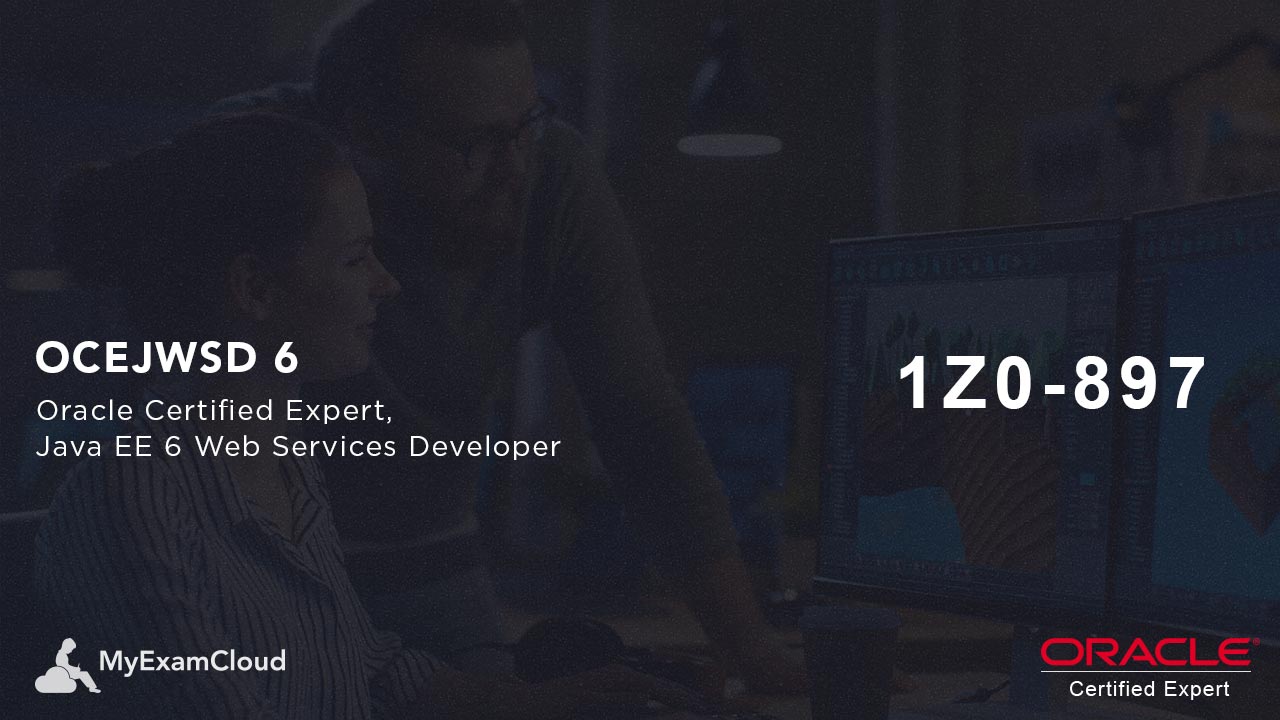
Certification Overview
The OCEJWSD 6 (Oracle Certified Expert, EE 6 Web Services Developer) certification improves Java EE web services technology APIs (JAX-RS & JAX-WS) design and development skills. This Java Certification tests Java EE 6 Web Services key concepts, JAX-RS JSON based web services, JAX-WS SOAP based web services, Security, WS-Security, Web Services in core Java, Servlets and EJB. Java EE 6 specification has been updated for these new features, so the experienced Java EE developers also need to learn this new changes by preparing for this exam.
This certification gives candidates the information they need to create, implement, and deploy web services using Java technology components and the Java Platform Enterprise Edition 6 software development kit.
Candidates looking to take this exam should already be familiar with web services as a realisation of Service Oriented Architecture and how to use Java EE best practices when designing web services.
The examination includes the following topics: create an SOAP web service in a servlet container, create a RESTful web service in a servlet container, create an SOAP-based web service implemented by an EJB component, create a RESTful web service implemented by an EJB component, configure Java EE security for an SOAP web service, create a web service client for an SOAP-based web service, create a web service client for a RESTful web service, create a SOAP-based web service using Java SE platform, create handlers for SOAP web services, create low-level SOAP web services, use MTOM and MIME in an SOAP web service, use WS-Addressing with an SOAP web service, configure Message Level security for an SOAP web service, and applying best practices to design and implement web services.
Certification Process
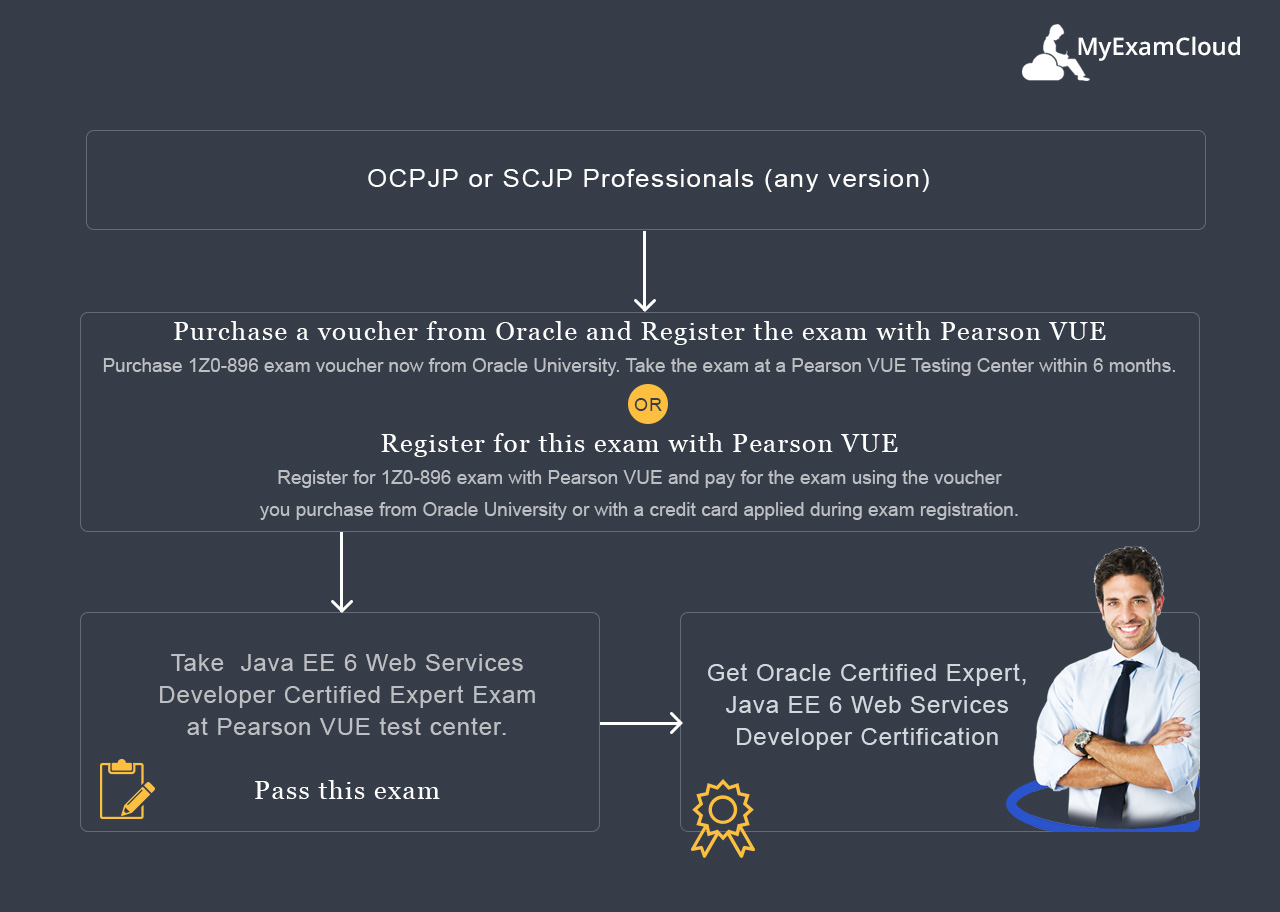
Exam Details
| Exam Number | 1Z0-897 |
|---|---|
| Exam Name | Java EE 6 Web Services Developer Certified Expert |
| Exam Duration | 90 minutes |
| Number of Questions | 55 |
| Passing Score | 65% |
| Validated Against | Java EE 6 |
| Format | Multiple Choice |
Syllabus
- Create an SOAP web service in a servlet container
- Create a RESTful web service in a servlet container
- Create a SOAP based web service implemented by an EJB component
- Create a RESTful web service implemented by an EJB component
- Configure JavaEE security for a SOAP web service
- Create a web service client for a SOAP based web service
- Create a web service client for a RESTful web service
- Create a SOAP based web service using Java SE platform
- Create handlers for SOAP web services
- Create low-level SOAP web services
- Use MTOM and MIME in a SOAP web service
- Use WS-Addressing with a SOAP web service
- Configure Message Level security for a SOAP web service
- Apply best practices to design and implement web services
Preparation
Sample content for preparation. Sample content for preparation. Sample content for preparation. Sample content for preparation.
Who can take this certification?
Set The New Java Standard With Java EE 6 Web Services Certification Java EE 6 significantly changes the web services technology and APIs. Java EE 6 Web Services Certification gives you the tools to make the most of new features. The Java EE 6 Oracle Certified Expert (OCE) Web Services Certification provides a foundational understanding of Java EE web services using JAX-WS and JAX-WS. So it suits for most Java EE Professionals starting from beginner to expert.
- Java EE Aspirants
- Java EE Developer looking for Job
- Java EE Trainers
Benifits
The reason for taking Oracle Java Certification is to differentiate general programmers from certified experts. You may get additional benefits like getting a good job, salary hike, designation changes, role changes and higher promotion.
Stand out from the millions of Java crowd. Increase your marketability with OCEWSD 6 Certification on the most used programming language in the world - Java.
The certification empowers in driving Java EE Technologies for SOA based applications. OCE for Java EE 6 Web Services certified experts can easily evaluate various design options (SOAP, REST, JSON), APIs (JAX-WS, JAX-RS, JAXB), software COTS components, etc.
Success Story
Thanh son Le
I found the Training Lab Exams to be fantastic! The questions were more intense than the actual exams. It has become a common practice for the training staff at our company to recommend your products. Thanks!
Oracle Certified Expert, EE 6 Java Persistence API Developer
Learn More StudyPlan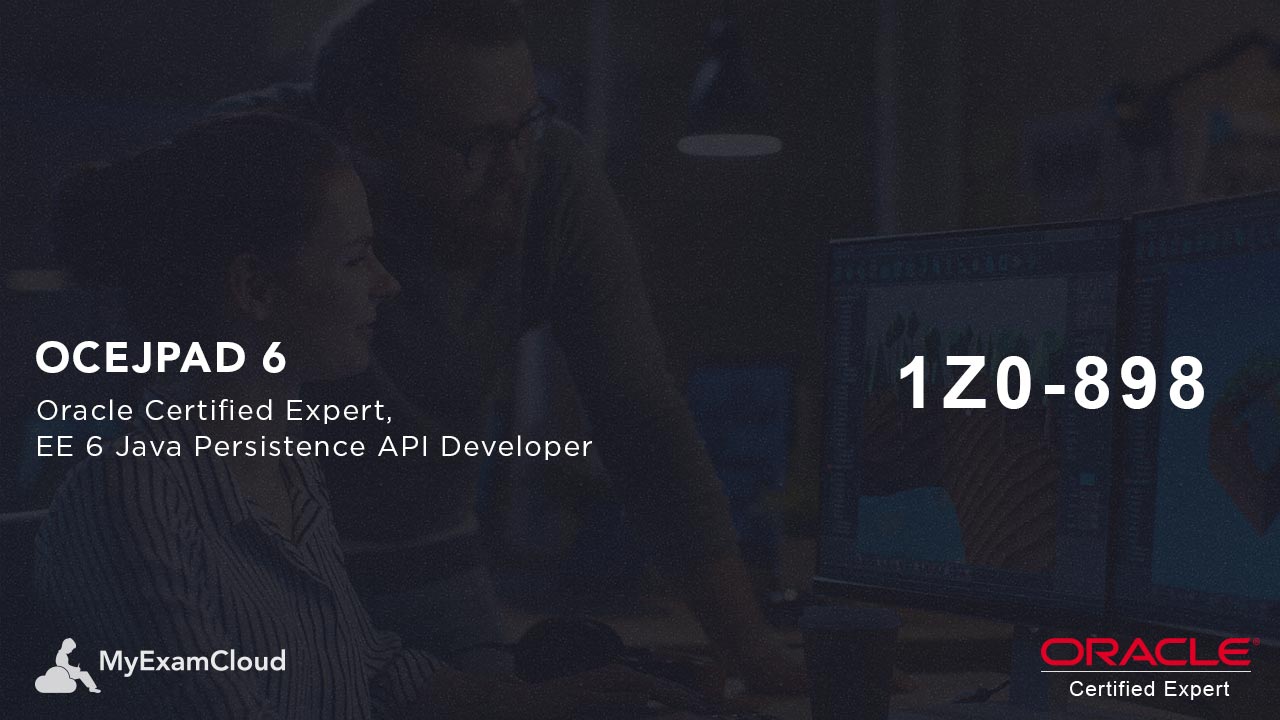
Certification Overview
The OCEJPAD 6 (Oracle Certified Expert, EE 6 Java Persistence API Developer) certification improves Java EE database integration tier technology design and development skills. This Java Certification tests Java EE 6 JPA key concepts, entity relationships, design robust entity model, CRUD operations, data validation, performance optimization, transaction & locking, ORM techniques, static & dynamic queries, and criterial API. Java EE 6 specification has been updated for these new features, so the experienced Java EE developers also need to learn this new changes by preparing for this exam.
Before taking this exam, you should already have the knowledge needed to build robust back-end functionality using Enterprise JavaBeans (EJB) technology. You should also be familiar with the EJB technology coding experience of session beans and message driven-beans.
You should have completed an Oracle or Sun certified Java programmer certification (any version is fine) before taking this exam.
The topics covered in the exam are: overview of the Java Persistence API, introducing the Auction Application, Java Persistence API Entities, understanding the Entity Manager, modeling Entity Relationships, Entity inheritance and object-relational mapping, persisting enums and collections, introduction to querying, using the Java Persistence API Query language, using the Java Persistence API Criteria API, using the Java Persistence API in a container, implementing transactions and locking, and advanced Java persistence API concepts.
Certification Process
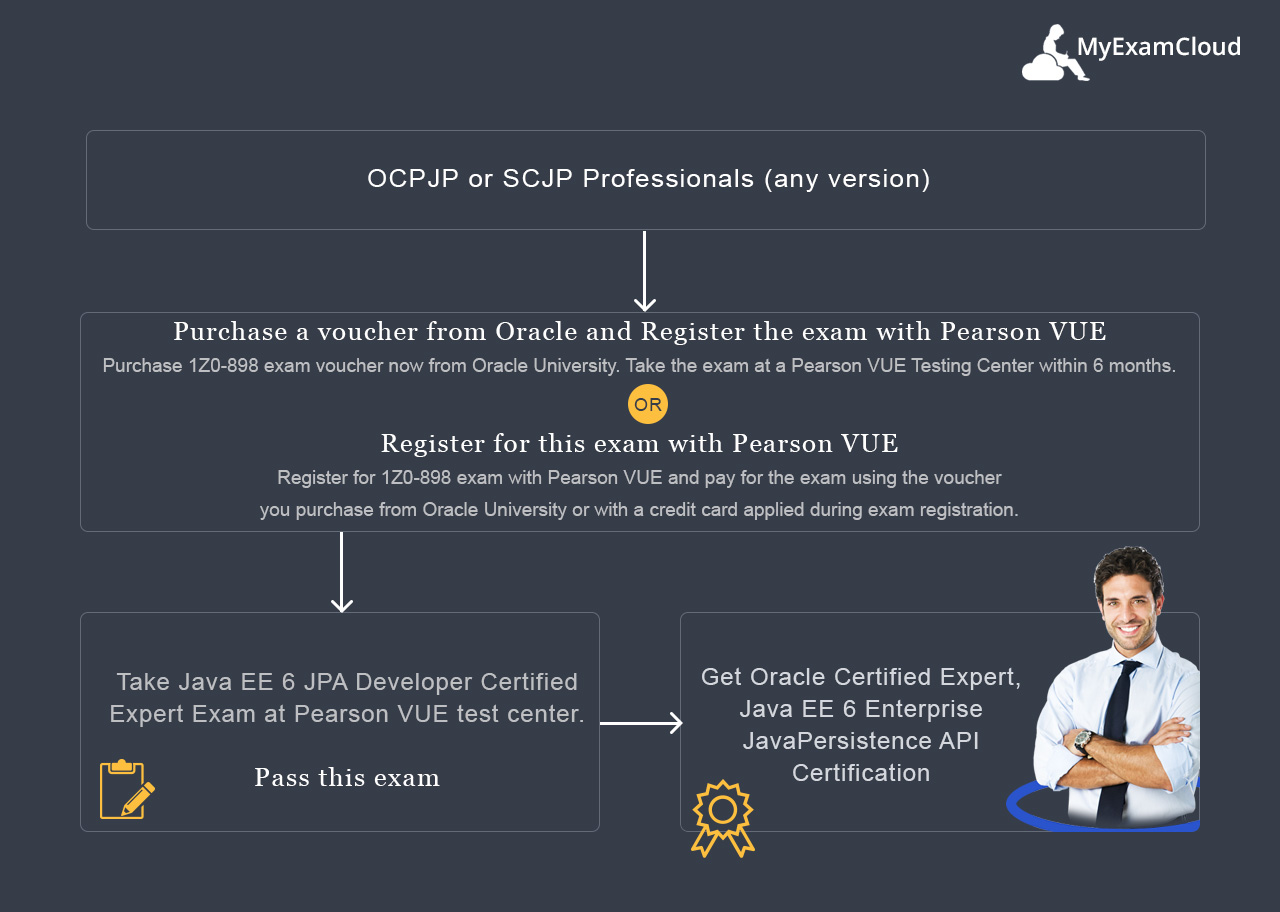
Exam Details
| Exam Number | 1Z0-898 |
|---|---|
| Exam Title | Java EE 6 Java Persistence API Developer Certified Expert |
| Exam Duration | 135 minutes |
| Number of Questions | 64 |
| Passing Score | 61% |
| Validated Against | Java EE 6 |
| Format | Multiple Choice |
Syllabus
Overview of the Java Persistence API
- Describe the basics of Object Relational Mapping (ORM)
- Define the key concepts of the Java Persistence API (entity, entity manager, and persistence unit)
Introducing the Auction Application
- Describe the auction application
- Define the domain objects of the auction application
- Describe the implementation model for the auction system
Java Persistence API Entities
- Describe the difference between objects and entities
- Describe the difference between persistent fields and properties
- Identify and use common Java Persistence API annotations, such as @Entity, @Id, @Table, and @Column
Understanding the Entity Manager
- Describe the relationship between an entity manager, a persistence context, and a persistence unit
- Describe the difference between a container-managed entity manager and an application-managed entity manager
- Describe the entity life cycle
Modeling Entity Relationships
- Examine association relationships in the data and object models
- Use relationship properties to define associations
- Implement one-to-one unidirectional associations
- Implement one-to-one bidirectional associations
- Implement many-to-one/one-to-many bidirectional associations
- Implement many-to-many bidirectional associations
- Implement many-to-many unidirectional associations
- Examine fetch and cascade mode settings
Entity Inheritance and Object-Relational Mapping
- Examine entity inheritance
- Examining object/relational inheritance hierarchy mapping strategies
- Inherit from an entity class
- Inherit using a mapped superclass
- Inherit from a non-entity class
- Examine inheritance mapping strategies
- Use an embeddable class
Persisting Enums and Collections
- Persist entities that contain enums with @Enumerated
- Persist entities that contain lists with @ElementCollection
- Persist entities that contain maps with @ElementCollection
Introduction to Querying
- Find an Entity by its primary key
- Understand basic Java Persistence API query language queries
- Understand native SQL queries
- Understand basic Criteria API queries
Using the Java Persistence API Query Language
- Examine the Java Persistence API query language
- Create and use the SELECT statement
- Create and use the UPDATE statement
- Create and use the DELETE statement
Using the Java Persistence API Criteria API
- Contrast queries that use the Criteria API with queries that use the Java Persistence query language
- Describe the metamodel object approach to querying
- Create Criteria API queries
Using the Java Persistence API in a Container
- Use the Java Persistence API from a servlet
- Use the Java Persistence API from a stateless session bean
Implementing Transactions and Locking
- Describe the transaction demarcation management
- Implement container-managed transactions (CMT)
- Interact programmatically with an ongoing CMT transaction
- Implement bean-managed transactions (BMT)
- Apply transactions to the Java Persistence API
Advanced Java Persistence API Concepts
- Specify composite primary keys
- Override mappings with the @AttributeOverride and @AssociationOverride annotations
Understand entity listeners and callback methods
Preparation
Sample content for preparation. Sample content for preparation. Sample content for preparation. Sample content for preparation.
Who can take this certification?
Set The New Java Standard With Java EE 6 JPA Certification: Java EE 6 significantly changes the business & persistence tier components and APIs. Java EE 6 JPA Certification gives you the tools to make the most of new features. The Java EE 6 Oracle Certified Expert (OCE) JPA Certification provides a foundational understanding of Java EE Integration Tier as well as JPA programming in general. So it suits for most Java EE Professionals starting from beginner to expert.
- Java EE Aspirants
- Java EE Developer looking for Job
- Java EE Trainers
Benifits
The reason for taking Oracle Java Certification is to differentiate general programmers from certified experts. You may get additional benefits like getting a good job, salary hike, designation changes, role changes and higher promotion.
Stand out from the millions of Java crowd. Increase your marketability with OCEEJBD 6 Certification on the most used programming language in the world - Java.
Oracle Certified JPA Developers are familiar with the JPA coding experience of entities. Through careful exam preparation, they should also gain an understanding of entity design, best practices, transaction management, locking fundamentals, and security.
After completing EJB and JPA certifications you can easily complete Oracle Certified Enterprise Architect (OCMJEA) certification. This certification plays vital role in architecture and designing Java Platform, Enterprise Edition technology-compliant applications that are scalable, flexible, and highly secure.
Success Story
Thanh son Le
I found the Training Lab Exams to be fantastic! The questions were more intense than the actual exams. It has become a common practice for the training staff at our company to recommend your products. Thanks!
Oracle Certified Expert, Java EE 6 Enterprise JavaBeans Developer
Learn More StudyPlan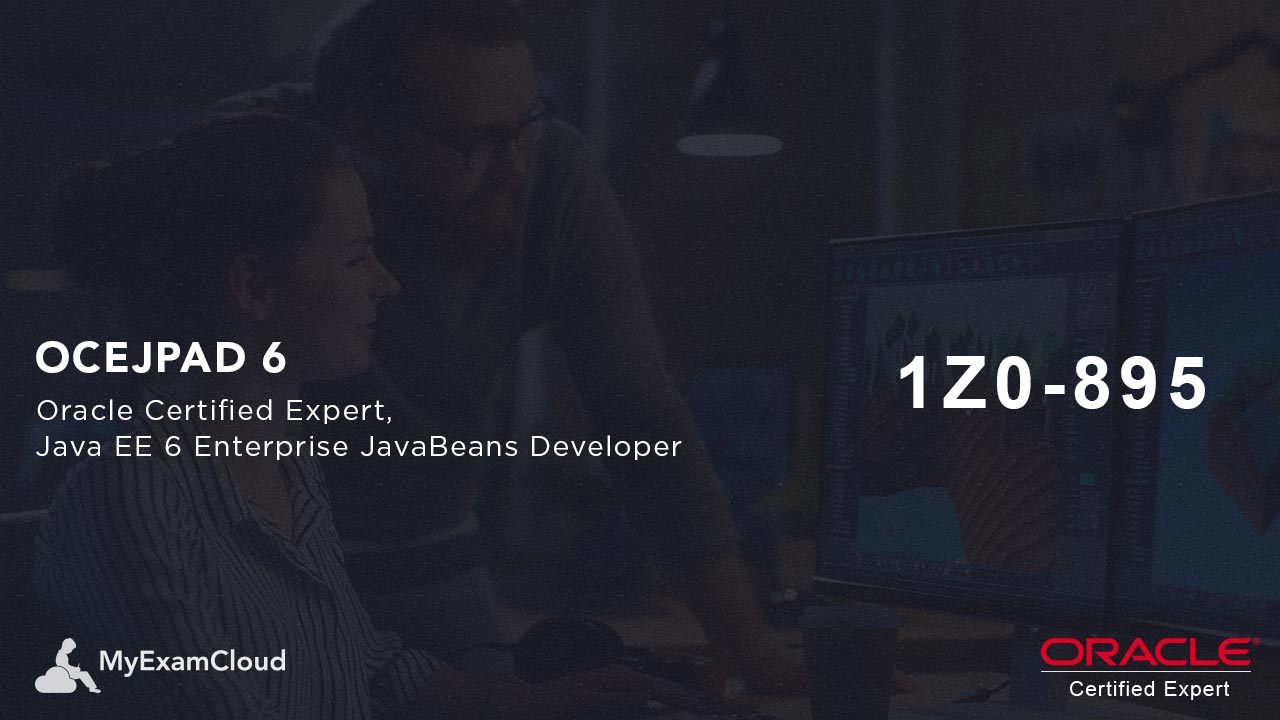
Certification Overview
The OCEEJBD 6 (Oracle Certified Expert, EE 6 Enterprise JavaBeans Developer) certification improves Java EE business tier technology design and development skills. This Java Certification also tests Java EE 6 EJB types (Stateless, Stateful, Singleton and Message Driven Bean), JMS API, EJB Timer, Transaction, Security, EJB Design, Patterns, packaging and deployment. Java EE 6 specification has been updated for these new features, so the experienced Java EE developers also need to learn this new changes by preparing for this exam.
The Java EE 6 Enterprise JavaBeans (EJB) Developer certification requires the knowledge and understanding to create thorough back-end functionality using the most up to date Enterprise JavaBeans technology.
Those seeking certification should also be familiar with EJB design, best practices, and security.
The examination covers topics including: introduction to Java EE, implementing session beans, accessing session beans, advanced session bean concepts, singleton session bean, developing Java EE applications using messaging, developing message-driven beans, using timer ServicesObjectives, implementing interceptor classes and methods, implementing transactions, implementing security, using EJB technology best practices, package and deploy EJB applications, and perform EJB exception handling.
Certification Process
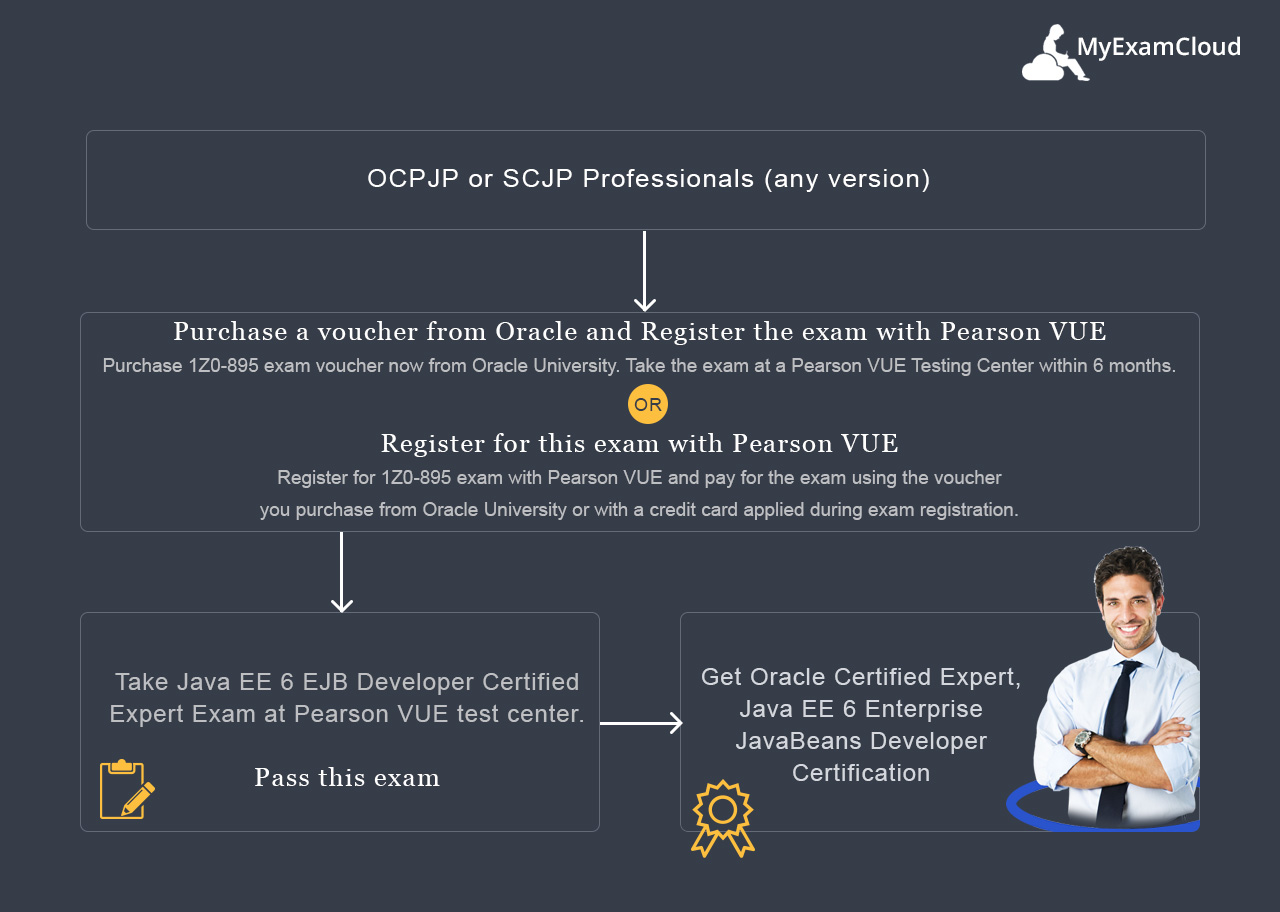
Exam Details
| Exam Number | 1Z0-895 |
|---|---|
| Exam Title | Java EE 6 Enterprise JavaBeans Developer Certified Expert |
| Duration | 110 minutes |
| Number of Questions | 60 |
| Passing Score | 73% |
| Validated Against | Java EE 6 |
| Format | Multiple Choice |
Syllabus
Introduction to Java EE
- Gain an understanding of the Java Platform, Enterprise Edition (Java EE)
- Examine the Java EE application architecture
- Examine Java EE container services
- Examine the EJB component types
- Evaluate the EJB Lite Container
- Compare Java EE application development with traditional enterprise application development
Implementing Session Beans
- Examine session beans
- Identify the three types of session beans
- Choose the correct session bean type given a business constraint
- Create session beans Package and deploy session beans
Accessing Session Beans
- Understand the purpose and role of JNDI in relation to EJB components
- Configure JNDI environment properties
- Use JNDI to look up a resource
- Write code that receives a resource reference through injection
- Create a session bean client
- Create a session facade
- Use dependency injection to locate an EJB
Advanced Session Bean Concepts
- Understand the relationship between the EJB container and an EJB component
- Describe the life cycle for stateless and stateful session beans
- Implement session bean life cycle methods
- Use a session bean to perform asynchronous communication
- Have fine-grained control over packaging and deployment
Singleton Session Bean
- Understand the advantages and disadvantages of using a singleton session bean
- Create a singleton session bean
- Describe the life cycle of a singleton session bean
- Implement singleton session bean life cycle methods
- Describe singleton concurrency access
- Implement a concurrency management strategy
Developing Java EE Applications Using Messaging
- Review JMS technology
- Describe the roles of the participants in the JMS API messaging system
- Create a queue message producer
- Create a synchronous message consumer
Developing Message-Driven Beans
- Understand the short-comings of using session beans as messaging consumers
- Describe the properties and life cycle of message-driven beans
- Create a JMS message-driven bean
- Create life cycle event handlers for a JMS message-driven bean
- Configure a JMS message-driven bean
Using Timer ServicesObjectives
- Describe timer services
- Create a timer notification callback
- Process a timer notification callback Manage timer objects
Implementing Interceptor Classes and Methods
- Describe interceptors and interceptor classes
- Create a business interceptor method in the enterprise bean class
- Create an interceptor class
- Associate multiple business interceptor methods with an enterprise bean
- Include life cycle callback interceptor methods in an interceptor class
Implementing Transactions
- Describe transaction demarcation management
- Implement CMT
- Interact programmatically with an ongoing CMT transaction
- Implement BMT Apply transactions to messaging
Implementing Security
- Understand the Java EE security architecture
- Authenticate the caller Examine Java EE authorization strategies
- Use declarative authorization
- Use programmatic authorization Examine the responsibilities of the deployer
Using EJB Technology Best Practices
- Define best practices and state the benefits of using EJB technology best practices
- Select and apply known patterns to Java EE application design
- Incorporate effective exception handling into your Java EE application design
Preparation
Sample content for preparation. Sample content for preparation. Sample content for preparation. Sample content for preparation.
Who can take this certification?
Set The New Java Standard With Java EE 6 EJB Certification: Java EE 6 significantly changes the business tier components and APIs. Java EE 6 EJB Certification gives you the tools to make the most of new features. The Java EE 6 Oracle Certified Expert (OCE) EJB Certification provides a foundational understanding of Java EE Business Tier as well as EJB programming in general. So it suits for most Java EE Professionals starting from beginner to expert.
- Java EE Aspirants
- Java EE Developer looking for Job
- Java EE Trainers
Benifits
The reason for taking Oracle Java Certification is to differentiate general programmers from certified experts. You may get additional benefits like getting a good job, salary hike, designation changes, role changes and higher promotion.
Stand out from the millions of Java crowd. Increase your marketability with OCEEJBD 6 Certification on the most used programming language in the world - Java.
Through EJB certification, you can gain practical experience with the EJB technology coding of session beans and message driven-beans. After completing this certification, you can also be familiar with EJB design, best practices, transaction management, messaging fundamentals, and security.
After completing EJB and JPA certifications you can easily complete Oracle Certified Enterprise Architect (OCMJEA) certification. This certification plays vital role in architecture and designing Java Platform, Enterprise Edition technology-compliant applications that are scalable, flexible, and highly secure.
Related Articles: https://www.epractizelabs.com/myexamcloud/2017/04/20/oracle-java-certification-exam-preparation/
Success Story
Thanh son Le
I found the Training Lab Exams to be fantastic! The questions were more intense than the actual exams. It has become a common practice for the training staff at our company to recommend your products. Thanks!
Master Level
Java EE Master Certification
Oracle Certified Master, Java EE 6 Enterprise Architect
To become an Oracle Certified Master Java EE 6 Enterprise Architect, candidates must either complete one Java certification course or submit one of the archived courses they have already completed.
Oracle Certified Master, Java EE 6 Enterprise Architect (Exam)
Learn More StudyPlan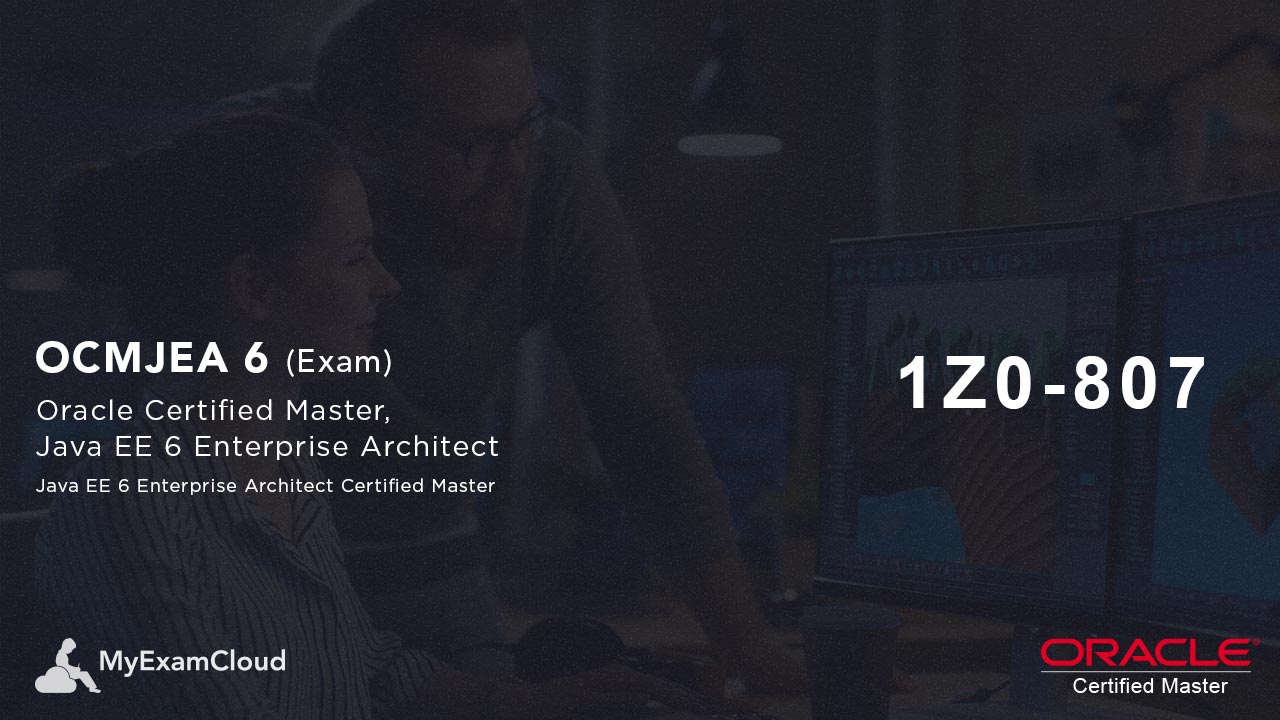
Certification Overview
The OCMJEA 6 (Java EE 6 Enterprise Architect Certified Master) Practice Tests guide you the Enterprise Architect’s roles, responsibilities and deliverables, Identify non-functional requirements (NFRs), common problems and solutions, translate business requirements into an architecture, best design choices in architecting the client, web, business, integration and data tiers, apply various evaluation criteria to choosing architectural elements & patterns, tools, servers and frameworks.
Certification Process
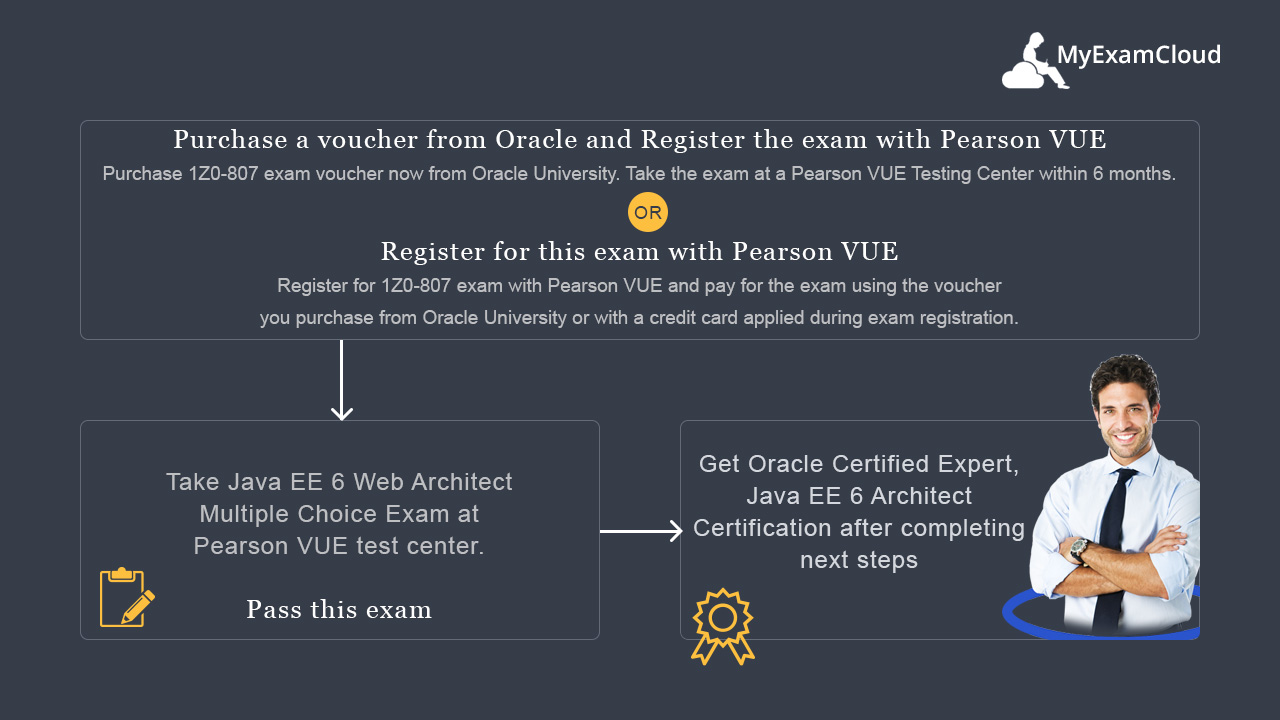
Exam Details
| Exam Number | 1Z0-807 |
|---|---|
| Exam Title | Java EE 6 Enterprise Architect Certified Master |
| Duration | 150 minutes |
| Number of Questions | 60 |
| Passing Score | 71% |
| Validated Against | Java EE 6 |
| Format | Multiple Choice |
Syllabus
Application Design Concepts and Principles
- Identify the effects of an object-oriented approach to system design including the effect of encapsulation, inheritance, and use of interfaces.
- Identify how the Separation of Concerns principle applies to the component model of a Java EE application; including client, the web and business component containers, and the integration and resource layers.
- Identify the correct interpretation of Separation of Concerns as it applies to the Java EE service layers, including component APIs, run-time containers, the operating system, and hardware resources.
- Identify non-functional and quality-of-service requirements that influence application design, including trade-offs in performance, availability, and serviceability.
Common Architectures
- Identify the appropriate strategy for deploying client applications to desktop and mobile platforms, the principles for designing a user interface and the benefits of applying client-tier patterns.
- Identify best practices for exception handling, logging, and business tier patterns.
- Identify design patterns that address specific challenges in the web tier, including authentication, authorization, and scaling and clustering to meet demand.
- Identify Java EE technologies, including JMS, JCA and Web Services, and design patterns that address specific challenges in enterprise integration.
- Identify the challenges in integrating enterprise resources, the Java EE technologies that address them (including JPA and JDBC), and the communication protocols that support tier-to-tier communication (including RMI, IIOP, and CORBA).
Integration and Messaging
- Identify the APIs available for a Java EE technology-based system to communicating with external resources, including JPA, JDBC, RMI, Web Services, JMS, and JCA. Outline the benefits and drawbacks of each approach.
- Describe the technologies used to integrate business components with Web Services, including XML over HTTP, JSON, SOAP and REST.
- Identify and detail the technologies used to integrate business components with external resources, including JMS and JCA.
- Identify how a Service Oriented Architecture (SOA) facilitates system integration and best practices.
Business Tier Technologies
- Identify the correct EJB technology to apply for a given scenario, including entity classes, session beans, message-driven beans, timers, interceptors, and POJOs.
- Identify benefits and drawbacks of different persistence technologies such as BMP, CMP, and JPA, including ease of development, performance, scalability, extensibility, and security.
- Identify the benefits and drawbacks of implementing Web Services in the EJB component container.
- Select the appropriate use of JPA and JPQL in a given scenario.
Web Tier Technologies
- Identify the benefits and drawbacks of using URL rewriting and cookies to manage HTTP session state.
- Identify appropriate uses for JSP and Servlet technology, and JavaServer Faces in a given Java EE application.
- Identify the benefits of using an EJB container with a web container instead of a web container alone.
- Identify the differences between client pull and server push architectures.
- Identify the benefits and drawbacks of using a browser to access asynchronous, lightweight processes on the server.
Design Patterns
- Demonstrate knowledge of Java EE design patterns including: Service Starter, Singleton, Bean Locator, Resource Binder, Dependency Injection, Payload Extractor, Context Holder, and Thread Tracker.
- Select an appropriate pattern for a given application challenge from the following: Facade, Strategy, Observer, Composite, and Abstract Factory.
- Identify a design pattern, using a description of its features, from the following: Facade, Strategy, Observer, Composite, and Abstract Factory.
- Identify the use of the law of leaky abstractions or a specific anti-pattern in a given scenario.
Security
- Identify elements of the security model in the Java SE environment for remote clients, including Web Start, applets and the role of the SecurityManager class.
- Select appropriate locations to implement Java EE security technologies or features in a UML component and deployment diagram.
- Classify security threats to an enterprise application select measures an architect can propose to mitigate them.
- Identify techniques associated with declarative and programmatic security, including the use of annotations, deployment descriptors, and JAAS technology.
- Identify the security technologies that apply to an application’s code, messaging and transport layers
Preparation
Sample content for preparation. Sample content for preparation. Sample content for preparation. Sample content for preparation.
Who can take this certification?
Set The New Java Standard With Java EE Architect Certification. The Java EE architect certification exam is a decent approach to distinguish your resume. Applicants who consistently guarantee they are up to speed on the most recent advances and hold significant certification in their picked technological advancements increase the value of their organizations. Any Java EE developer interested in architect career can take this exam.
- It is important that the person should have some exposure to design of Java applications including ability to think in terms of use cases, features and component etc.
- Prior exposure to UML diagrams and Design Patterns would be helpful.
- Working experience with one or more frameworks of Java EE stack like JSF, EJB, JAX-WS etc will help.
- The ideal working experience before sitting for the exam should be at least 6 – 8 years, unless the person has started designing and modelling JAVA applications from early on.
Benifits
The reason for taking Oracle Java Certification is to differentiate general programmers from certified experts. You may get additional benefits like getting a good job, salary hike, designation changes, role changes and higher promotion.
Stand out from the millions of Java crowd. Increase your marketability with OCMJEA 6 Certification on the most used programming language in the world - Java.
The certification empowers in driving Java EE Architecture for enterprise applications. OCMJEA 6 certified architects can easily evaluate various design options, frameworks, software COTS components, etc.
Success Story
Thanh son Le
I found the Training Lab Exams to be fantastic! The questions were more intense than the actual exams. It has become a common practice for the training staff at our company to recommend your products. Thanks!
Java (EE) Enterprise Architect Certified Master Assignment
Learn More StudyPlan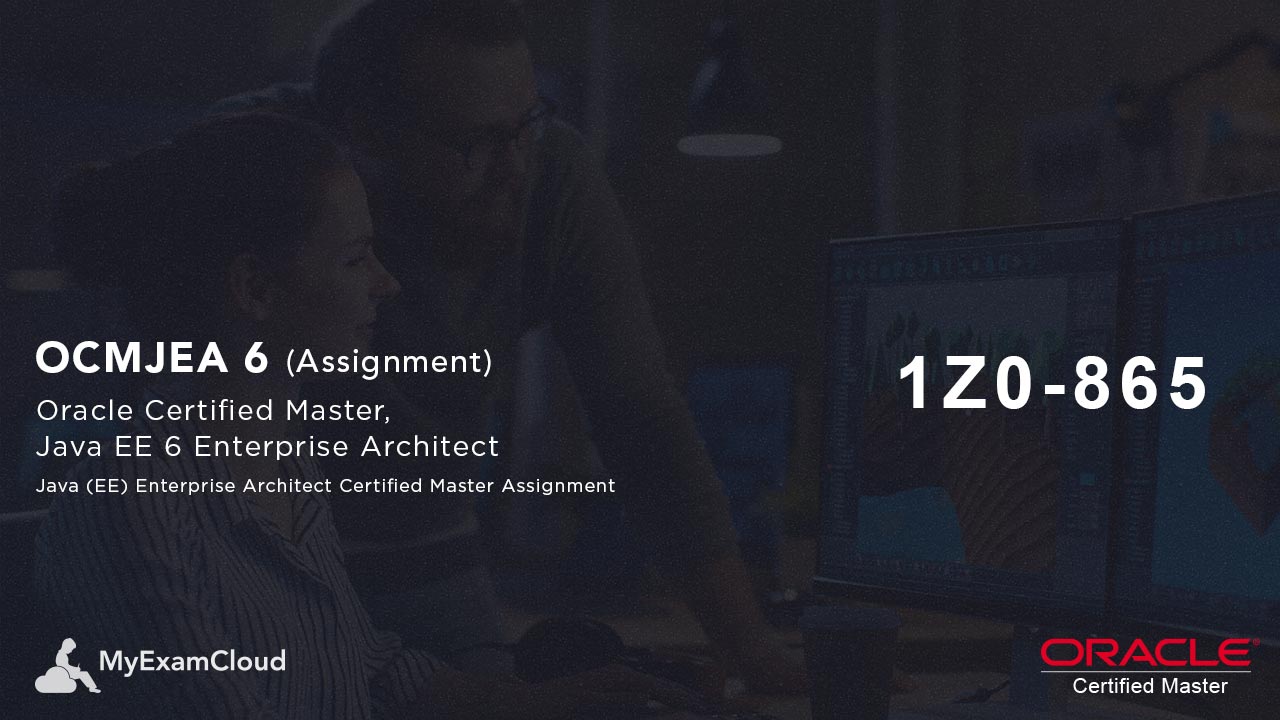
Certification Overview
The OCMJEA 6 (Java (EE) Enterprise Architect Certified Master) Assignment improves architecture skills using patterns, frameworks and UML diagrams.
Certification Process
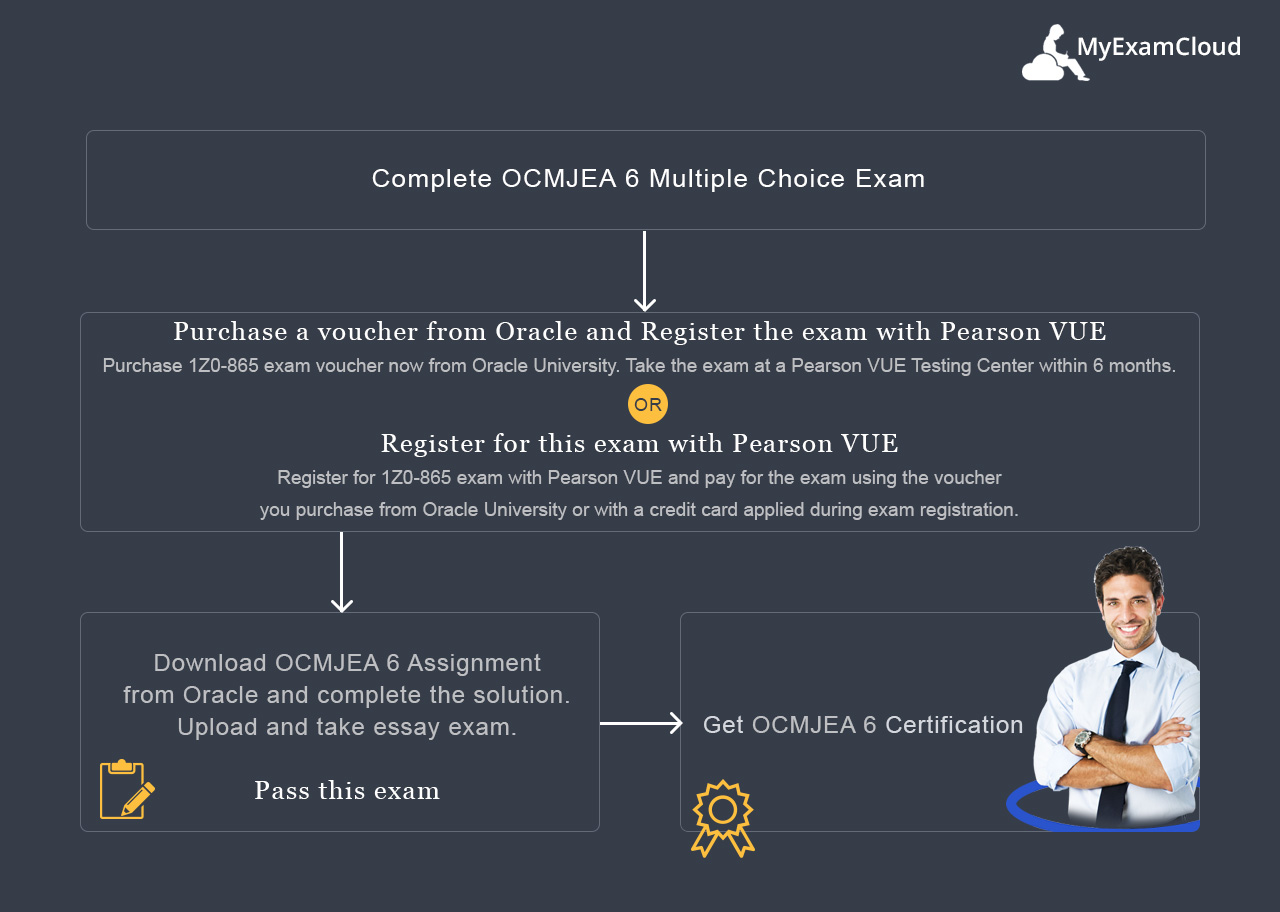
Exam Details
| Exam Number | 1Z0-865 |
|---|---|
| Exam Title | Java (EE) Enterprise Architect Certified Master Assignment |
| Duration | Six months from assignment purchase |
| Number of Questions | 60 |
| Passing Score | Subject to validation of assignment. |
| Validated Against | Validated against EE 5 and EE 6 |
| Format | Performance-based |
Syllabus
Section 1: Application Design Concepts and Principles
- Document a given system architecture by creating UML diagrams for it
- Explain the main advantages of an object-oriented approach to system design. including the effect of encapsulation, inheritance, and use of interfaces on architectural characteristics.
- Describe how the principle of "separation of concerns" has been applied to the main system tiers of a Java Platform, Enterprise Edition (Java EE) application. Tiers include client (both GUI and web), web (web container), business (EJB container), integration, and resource tiers.
- Describe how the principle of "separation of concerns" has been applied to the layers of a Java EE application. Layers include application, virtual platform (component APIs), application infrastructure (containers), enterprise services (operating system and virtualization), compute and storage, and the networking infrastructure layers.
Section 2: Common Architectures
- Explain the advantages and disadvantages of two-tier architectures when examined under the following topics: scalability, maintainability, reliability, availability, extensibility, performance, manageability, and security.
- Explain the advantages and disadvantages of three-tier architectures when examined under the following topics: scalability, maintainability, reliability, availability, extensibility, performance, manageability, and security
- Explain the advantages and disadvantages of multi-tier architectures when examined under the following topics: scalability, maintainability, reliability, availability, extensibility, performance, manageability, and security.
- Explain the benefits and drawbacks of rich clients and browser-based clients as deployed in a typical Java EE application.
- Create a logical and physical model of a system infrastructure architecture.
Section 3: Integration and Messaging
- Explain possible approaches for communicating with an external system from a Java EE technology-based system given an outline description of those systems and describe the benefits and drawbacks of each approach.
- Explain typical uses of web services and XML over HTTP as mechanisms to integrate distinct software components.
- Explain how JCA and JMS are used to integrate distinct software components as part of an overall Java EE application.
- Given a scenario, explain the appropriate messaging strategy to satisfy the requirements
Section 4: Business Tier Technologies
- Explain and contrast uses for entity beans, entity classes, stateful and stateless session beans, and message-driven beans and understand the advantages and disadvantages of each type.
- Explain and contrast the following persistence strategies: container-managed persistence (CMP), BMP, JDO, JPA, and ORM, and using DAOs (Data Access Objects) and direct JDBC technology-based persistence under the following headings: ease of development, performance, scalability, extensibility and security.
Section 5: Web Tier Technologies
- Given a system requirements definition, explain and justify your rationale for choosing a web-centric or EJB-centric implementation to solve the requirements. Web-centric means that you are providing a solution that does not use EJBs. An EJB component-centric solution will require an application server that supports EJB components.
Section 6: Applicability of Java EE Technology
- Given a specified business problem, design a modular solution that solves the business problem using Java EE technology.
- Given a specified business problem, identify and prioritize the main technology risk areas that must be addressed by the technical design and architecture.
- Explain how the Java EE platform enables service-oriented architecture (SOA) -based applications.
- Identify how the Java SE and Java EE platforms support the internationalization and localization of applications.
- Explain your rationale for choosing build as compared to buy for a given Java EE component
- Explain the typical challenges associated with the design and implementation of large scale enterprise software systems and how Java EE technology addresses those challenges.
- Explain how you would design a Java EE application to repeatedly measure critical non-functional requirements and outline a standard process with specific strategies to refactor that application to improve on the results of the measurements.
Section 7: Patterns
- From a list, select the most appropriate pattern for a given scenario. Patterns are limited to those documented in the book - Alur, Crupi and Malks (2003). Core J2EE Patterns: Best Practices and Design Strategies 2nd Edition and named using the names given in that book.
- From a list, select the most appropriate pattern for a given scenario. Patterns are limited to those documented in the book - Gamma, Erich; Richard Helm, Ralph Johnson, and John Vlissides (1995). Design Patterns: Elements of Reusable Object-Oriented Software and are named using the names given in that book.
- From a list, select the benefits and drawbacks of a pattern drawn from the book - Gamma, Erich; Richard Helm, Ralph Johnson, and John Vlissides (1995). Design Patterns: Elements of Reusable Object-Oriented Software.
- From a list, select the benefits and drawbacks of a specified Core J2EE pattern drawn from the book – Alur, Crupi and Malks (2003). Core J2EE Patterns: Best Practices and Design Strategies 2nd Edition.
Section 8: Security
- Given an architectural system specification, select the appropriate locations for implementation of specified security features, and select suitable technologies for implementation of those features
Identify and classify potential threats to a system and describe how a given architecture will address the threats.
Preparation
Sample content for preparation. Sample content for preparation. Sample content for preparation. Sample content for preparation.
Who can take this certification?
Set The New Java Standard With Java EE Architect Certification. The Java EE architect certification exam is a decent approach to distinguish your resume. Applicants who consistently guarantee they are up to speed on the most recent advances and hold significant certification in their picked technological advancements increase the value of their organizations. Any Java EE developer interested in architect career can take this exam.
- It is important that the person should have some exposure to design of Java applications including ability to think in terms of use cases, features and component etc.
- Prior exposure to UML diagrams and Design Patterns would be helpful.
- Working experience with one or more frameworks of Java EE stack like JSF, EJB, JAX-WS etc will help.
- The ideal working experience before sitting for the exam should be at least 6 – 8 years, unless the person has started designing and modelling JAVA applications from early on.
Benifits
The reason for taking Oracle Java Certification is to differentiate general programmers from certified experts. You may get additional benefits like getting a good job, salary hike, designation changes, role changes and higher promotion.
Stand out from the millions of Java crowd. Increase your marketability with OCMJEA 6 Certification on the most used programming language in the world - Java.
The certification empowers in driving Java EE Architecture for enterprise applications. OCMJEA 6 certified architects can easily evaluate various design options, frameworks, software COTS components, etc.
Success Story
Thanh son Le
I found the Training Lab Exams to be fantastic! The questions were more intense than the actual exams. It has become a common practice for the training staff at our company to recommend your products. Thanks!
How to prepare for a Java certification?
The Java Certification preparation require good study materials, books and online practice tests. The time required to complete Java Certification exam depends on your current circumstance and time. Make a prep plan to suit your current Job and prepare regularly.
The above details are enough to know about Java Certification, so let’s discuss about the answers for the questions we started earlier.
- To prove your skills as evidence from Oracle.
- To land in good job.
- To get promotions.
- To get higher salary.
- To program better than your colleagues.
- To secure your job.
- To differentiate your skills from other Java Professionals.
- To learn latest technology changes.
- To learn best practices.
- To add more value on your career profile.
Yes, you will get lot of advantages while taking Java Certification.
- The preparation experience shapeup your technology skills.
- The exam completion experience boosts your confidence.
Yes, it is worth for your long-term Java career.
- You will be ranked among top while promotion
- You will be ranked among top during salary hike
- You will be ranked among top during job interviews
According to the latest Pearson VUE survey, 88% of IT professionals recommend certification to a colleague when discussing a career or advancement in IT.
Oracle is situated in the top five certification programs, and 74% of these respondents would like to earn more specialized certifications.

